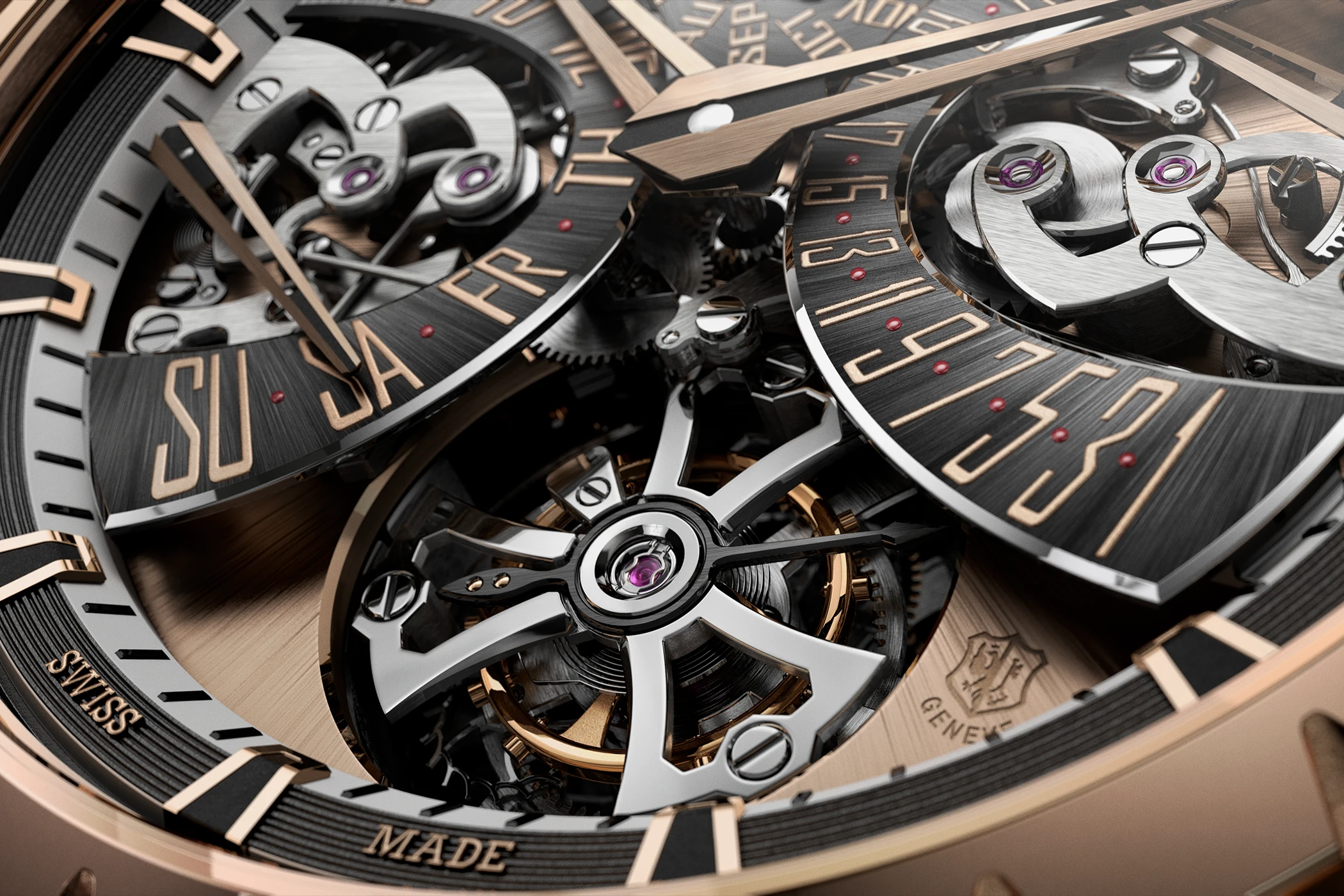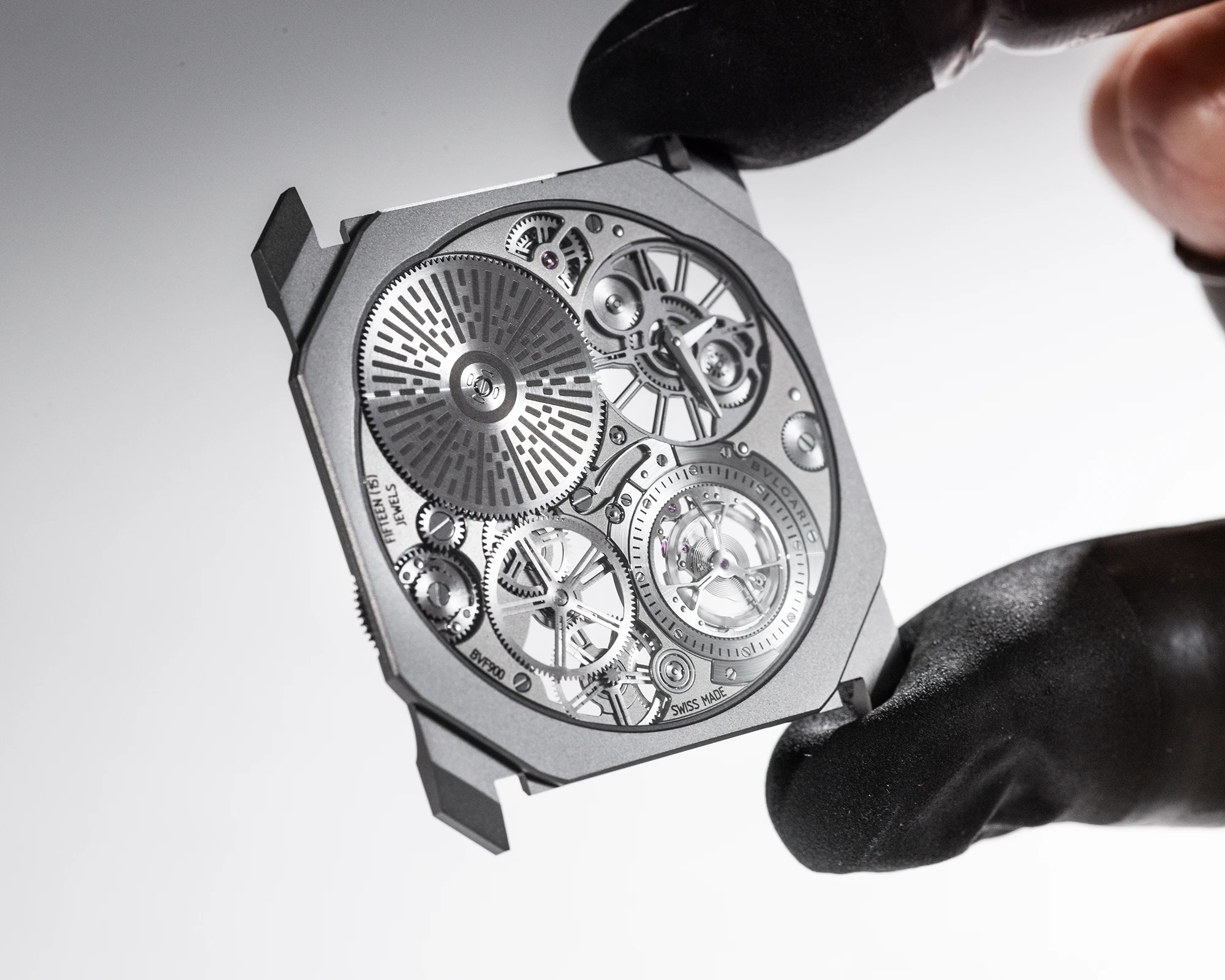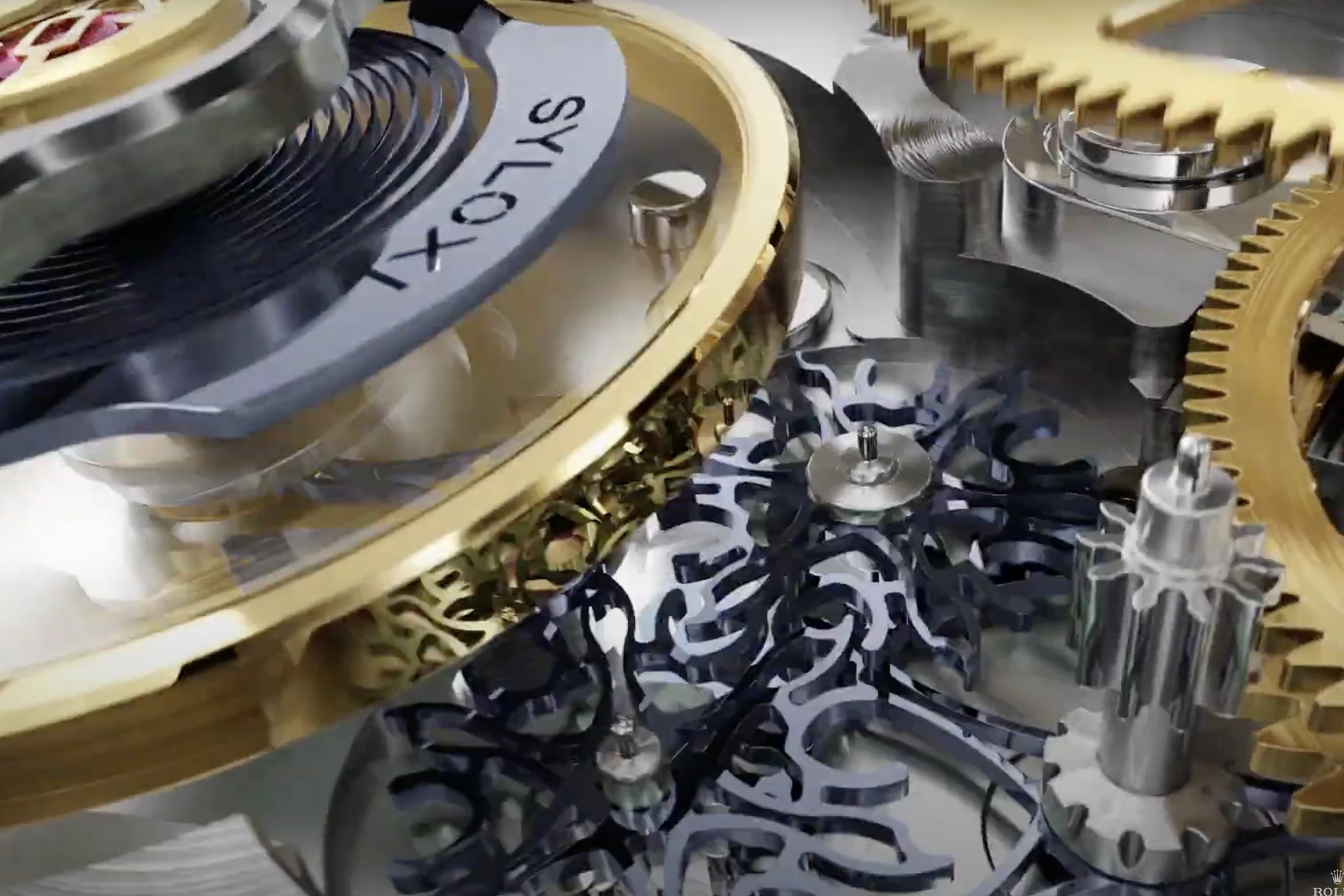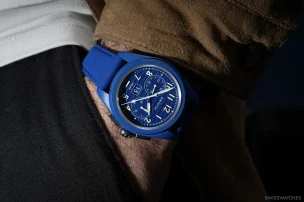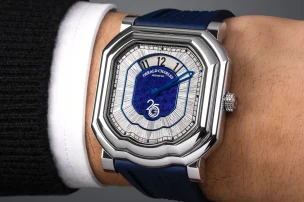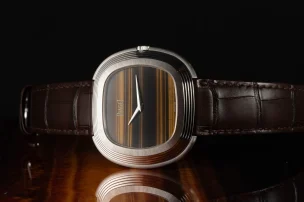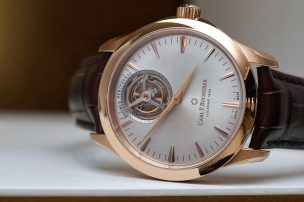
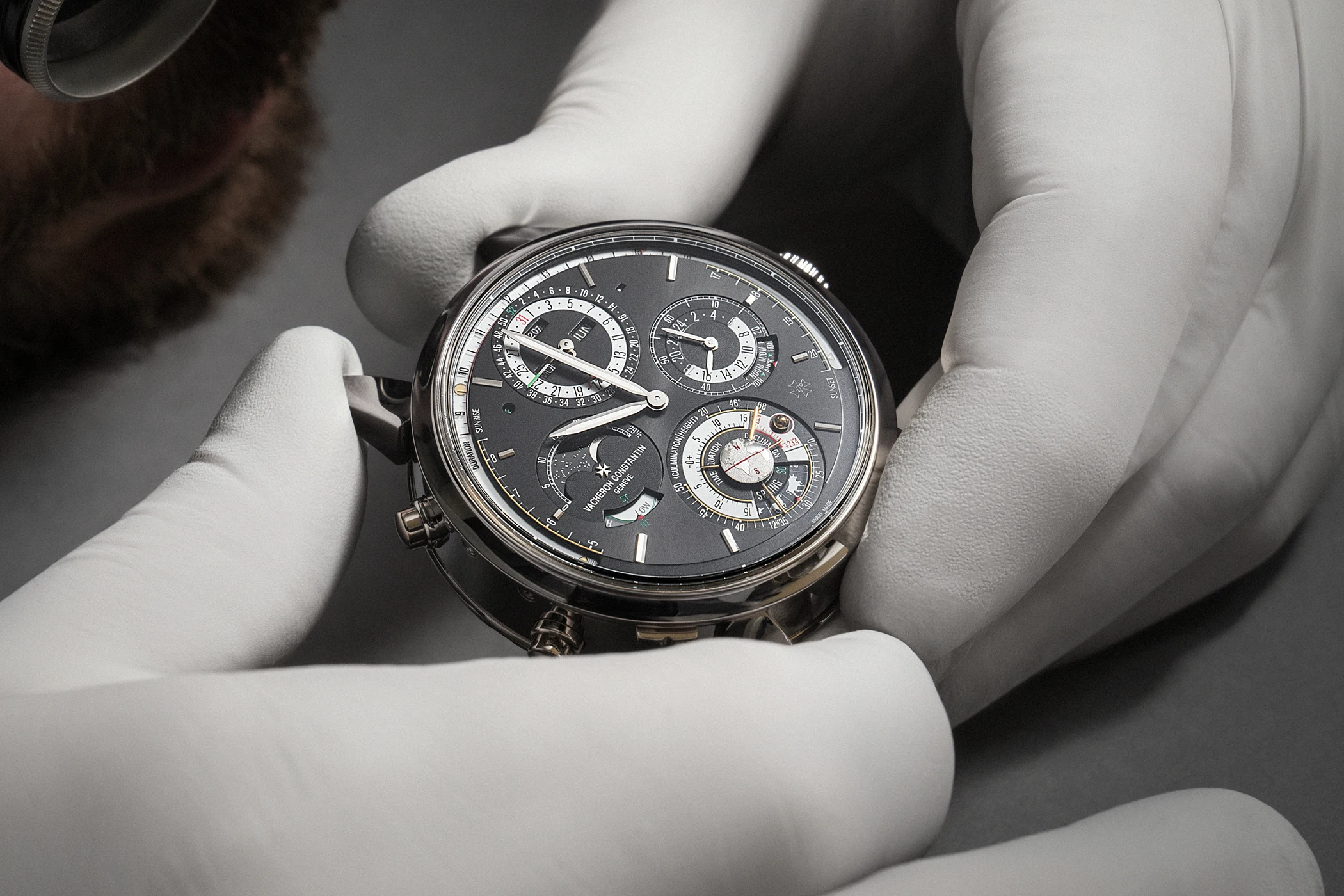
The Most Technically Advanced Watches at Watches & Wonders 2025
At Watches and Wonders 2025 in Geneva, there were some spectacular innovations and mechanical masterpieces on display. Among them were numerous complications, unprecedented displays, new solutions for well-known problems, a new escapement, and the most accurate mechanical wristwatch ever.
Vacheron Constantin Les Cabinotiers Solaria Ultra Grande Complication: Most Complicated Wristwatch
Vacheron Constantin sets a spectacular record with the Les Cabinotiers Solaria Ultra Grande Complication: with 41 complications, it is the most complicated wristwatch in the world. The in-house caliber 3655 has received 13 patents.
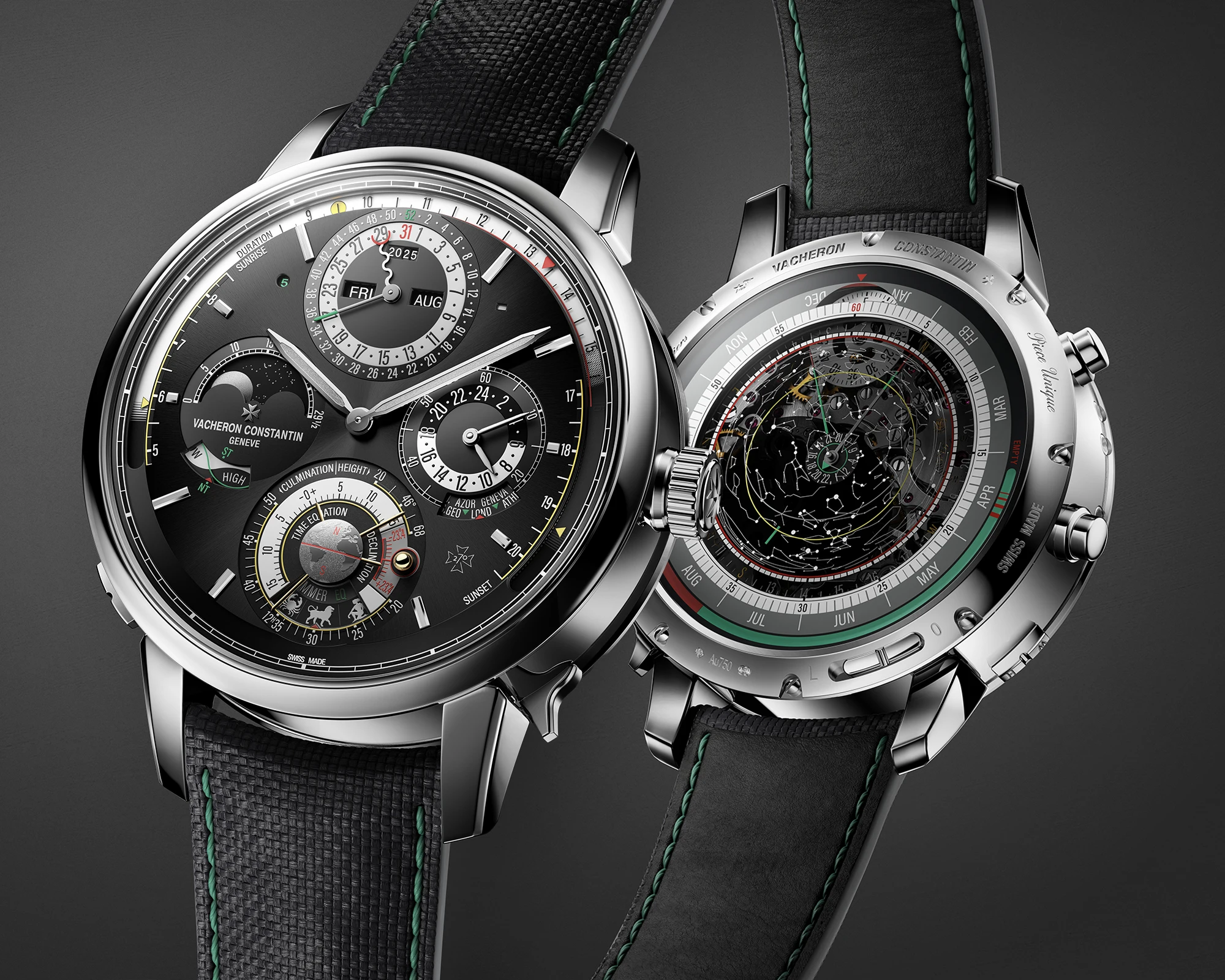
On the front of the piece unique, the hands from the center indicate civil time. At three o’clock, a second time zone is indicated, which can be selected via a slider on the case. The innovative solution employing a differential instead of a coupling is patented. At twelve o’clock, the displays of the perpetual calendar are consolidated. At nine o’clock, the moon phase and tides are shown. At six o’clock, there are indications of the sun’s altitude, culmination, and declination, as well as the equation and a disc with zodiac signs and seasons. The Solaria at the edge of the dial shows the position of the sun, as well as the times for sunrise and sunset.
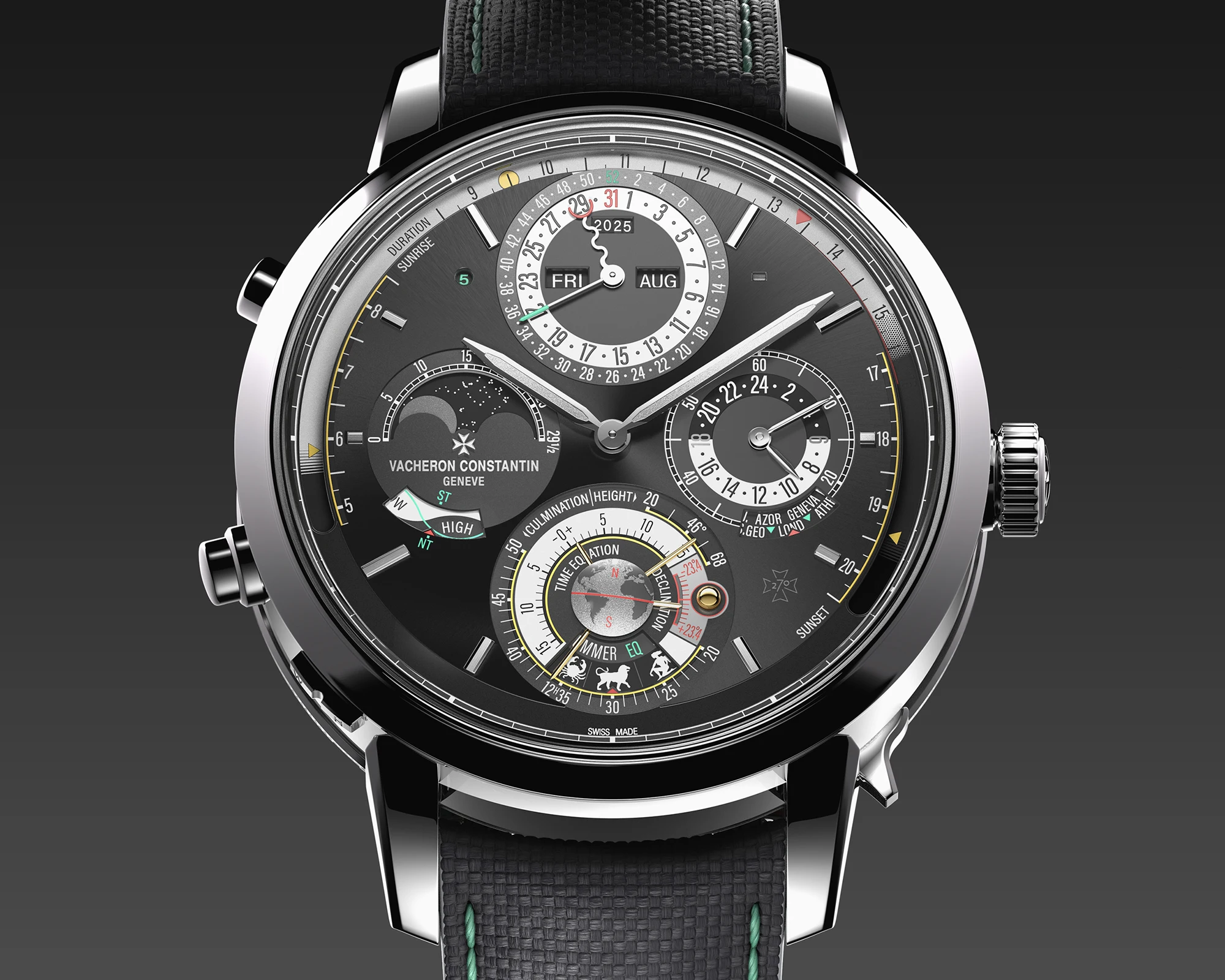
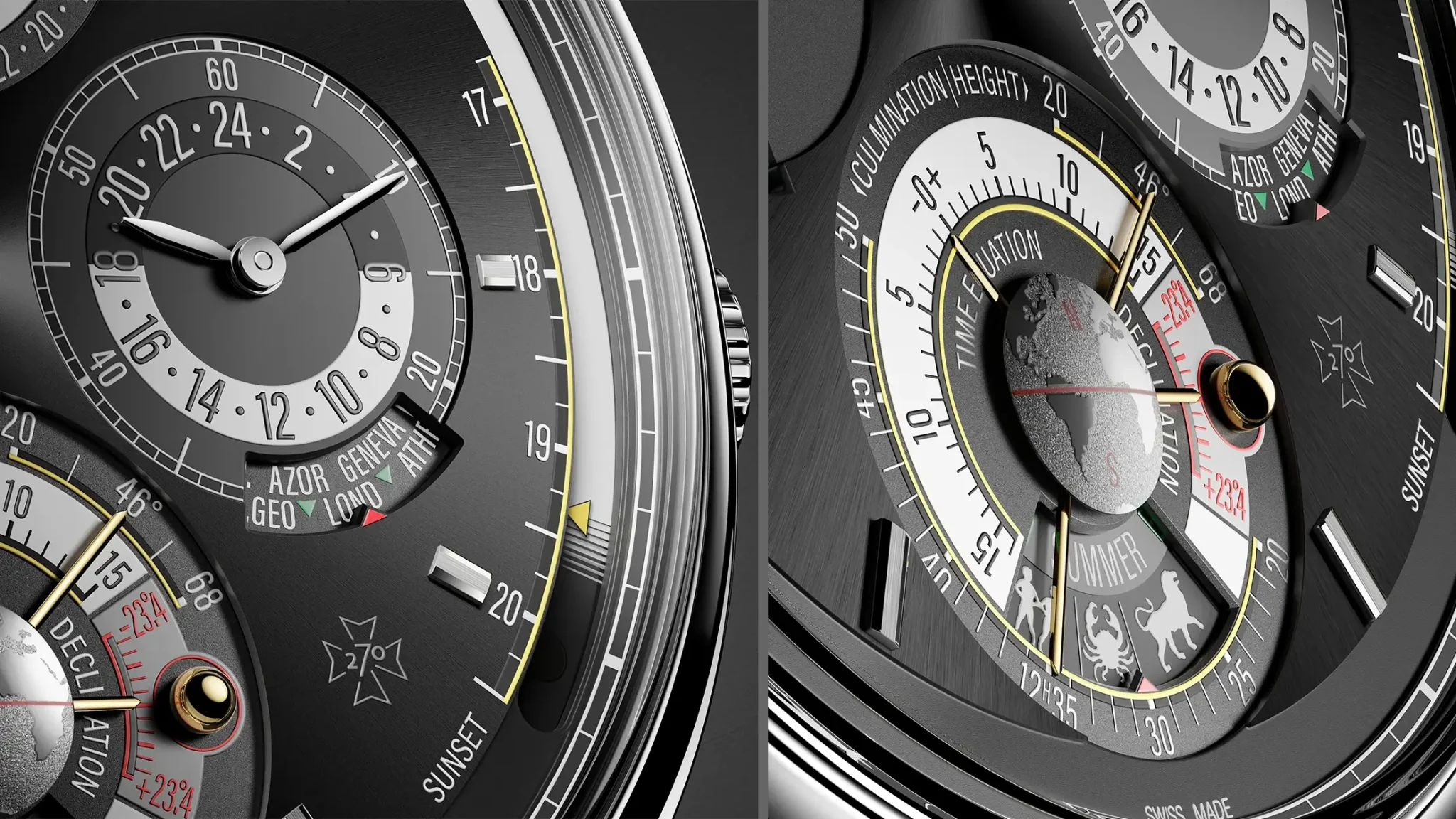
On the back, the display of sidereal time and the visible night sky is combined with the flyback chronograph, creating a complication never before realized in a wristwatch: To use this feature, start the chronograph and align the flyback hand with the star you are directly observing. You stop the second hand at the star you want to observe. The green triangle now indicates on the small 24-hour dial how long it will take for the second star to move into alignment with the observation line of the first star. Additionally, Vacheron received a patent for the decoupling of the flyback hand. Normally, glide friction affects the accuracy of timekeeping in this scenario. Also on the back, there is a power reserve indicator. The tourbillon, however, is not visible.
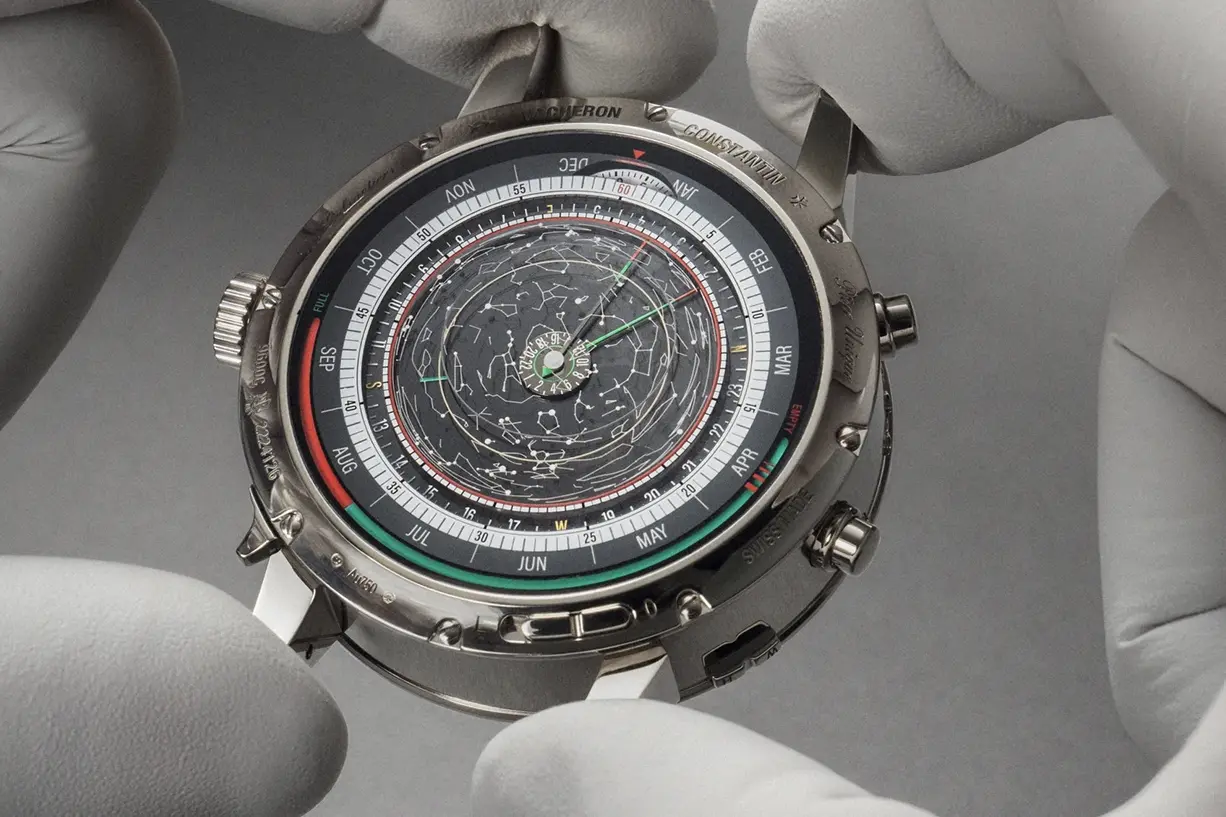
A slider on the case activates the minute repeater with Westminster chimes. This requires four sound springs and hammers to strike different melodies depending on the quarter hour. The striking mechanism can be switched between Westminster chimes and hour strikes. Here alone, Vacheron received seven patents, primarily focusing on space-saving innovations.
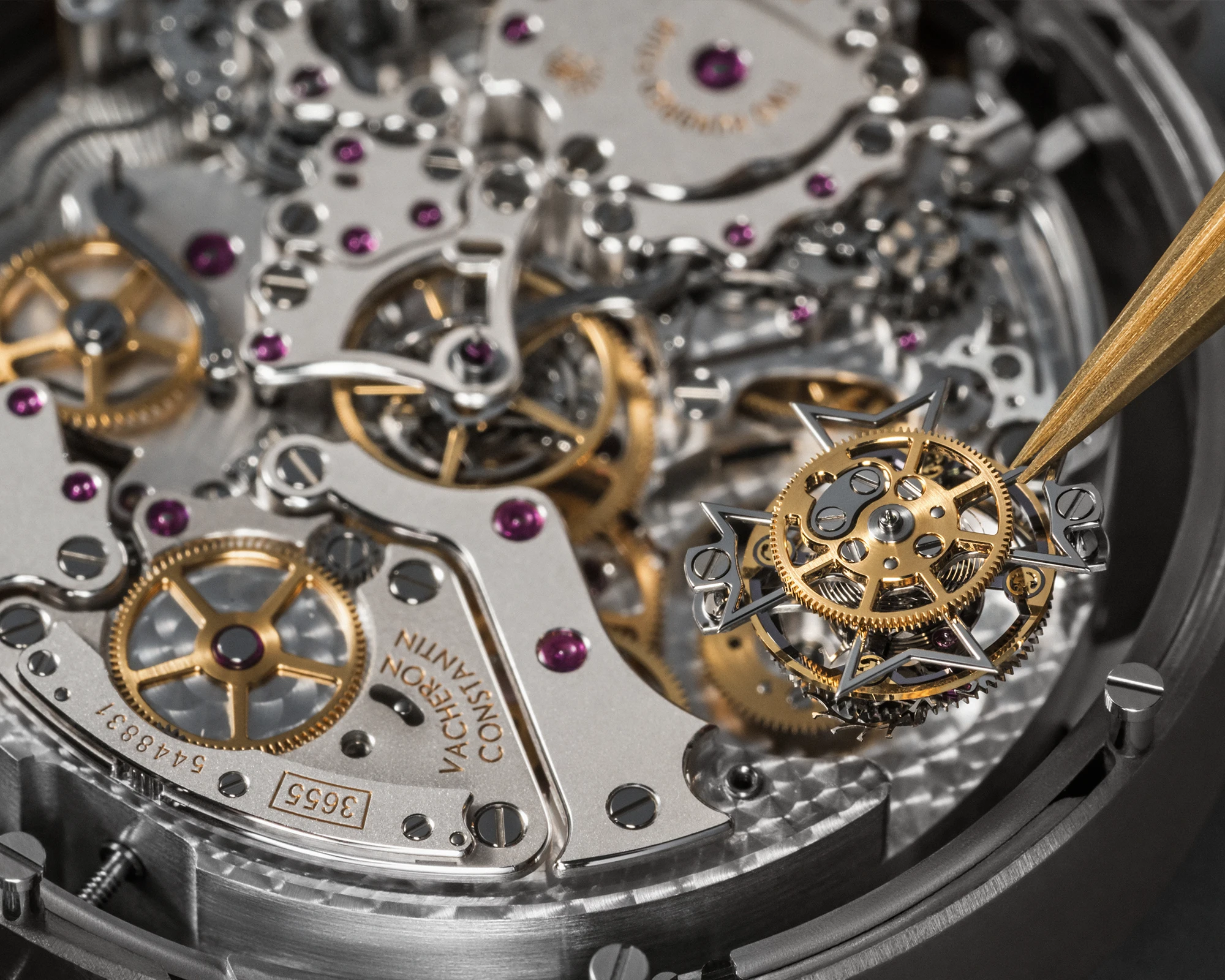
It is a high art to construct a record-setting timepiece that combines 41 complications. Vacheron has also succeeded in arranging the 1,521 components so compactly that the Solaria, with a diameter of 45 millimeters and a height of 14.99 millimeters, remains comfortably wearable. Additionally, the power reserve is impressive at 72 hours. What Vacheron Constantin has achieved here becomes evident when compared to the next watch from another famous Geneva manufacture, which, with significantly fewer complications, has a height that is 2.72 millimeters greater.

Patek Philippe Quadruple Complication
Patek Philippe is also a specialist in complications. The new reference 5308G Quadruple Complication includes a minute repeater, a split-seconds chronograph, and a perpetual calendar. Additionally, the caliber R CHR 27 PS QI winds automatically – something rarely seen in a Grande Complication. The movement comprises 799 parts.
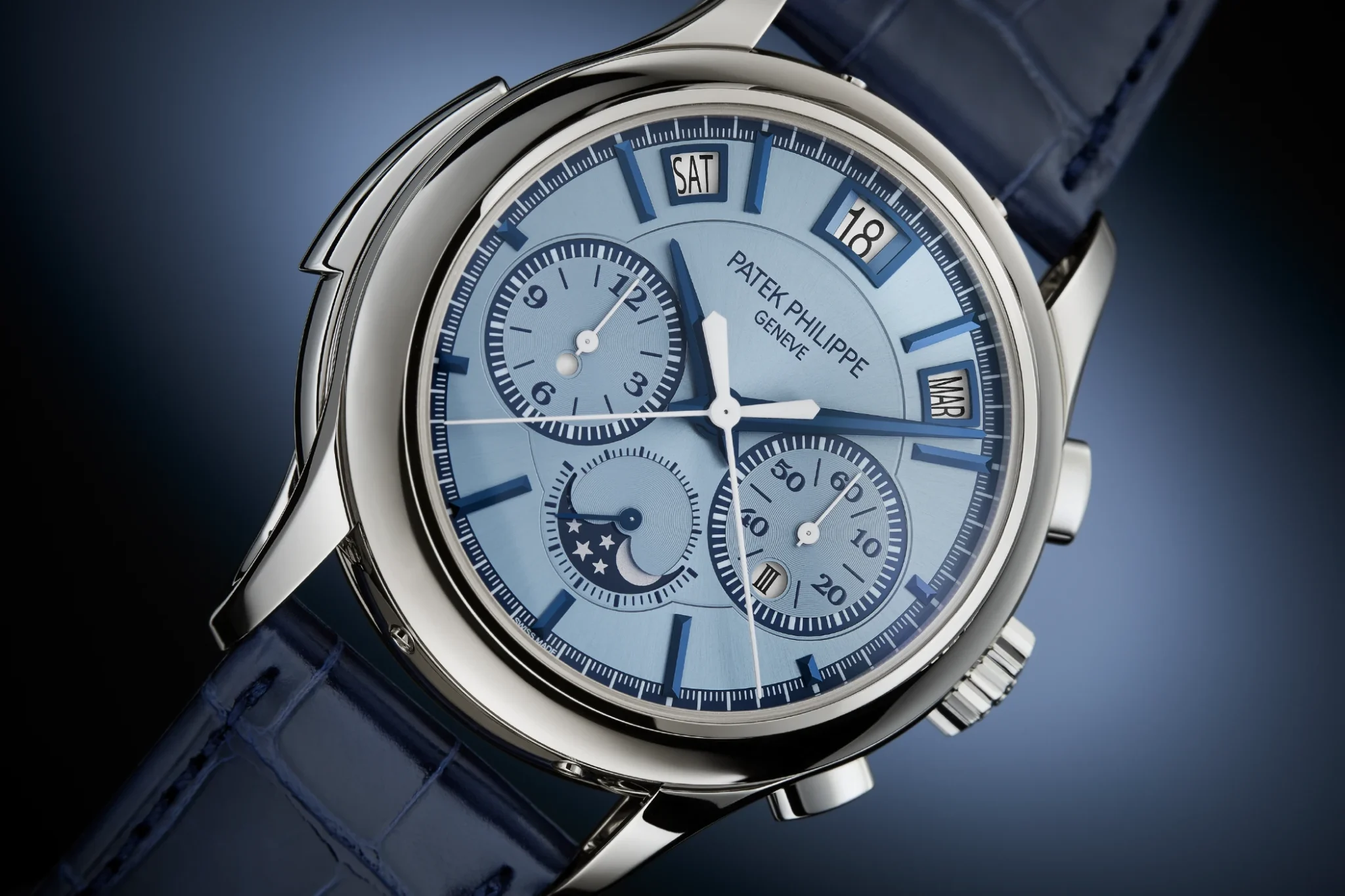
Two patents enhance the chronograph: Normally, there is a friction spring that compensates for gear play when engaging the chronograph and during operation, preventing any stuttering of the stop seconds hand. However, energy is lost through friction. Therefore, Patek has devised a new geometry for the clutch wheel: Tiny leaf springs are integrated into the long, slotted teeth, eliminating gear play without generating friction. This complex shape was made possible by producing the clutch wheel using the LIGA process (Lithography/Electroplating/Molding) from a nickel-phosphorus alloy.
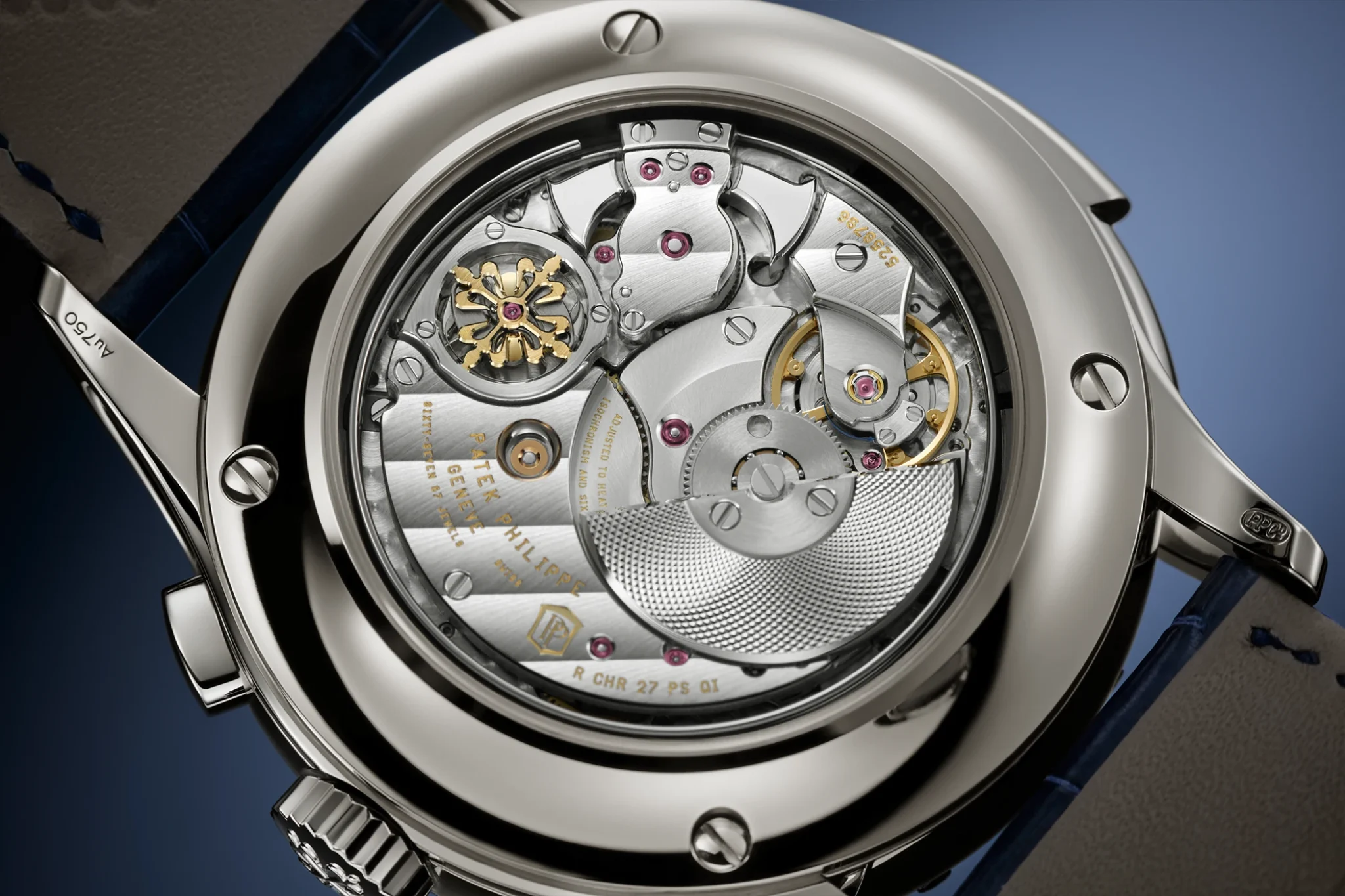
Another patent concerns the trailing seconds hand. Patek has further enhanced its own isolation mechanism. In this design, the trailing seconds hand is decoupled from the stop seconds hand by being lifted when it stops. This prevents sliding friction, which could otherwise lead to energy loss, reduced amplitude of the balance wheel, and consequently inaccurate timekeeping.
A specialty of Patek Philippe is the instantaneous perpetual calendar: all calendar displays advance within 30 milliseconds. Normally, this process takes longer than an hour, as the power needed to switch the displays cannot be taken from the gear train all at once—otherwise, the watch would stop. How does Patek solve this problem? A large lever made up of 15 parts gathers energy with a spring over several hours and then advances the displays.
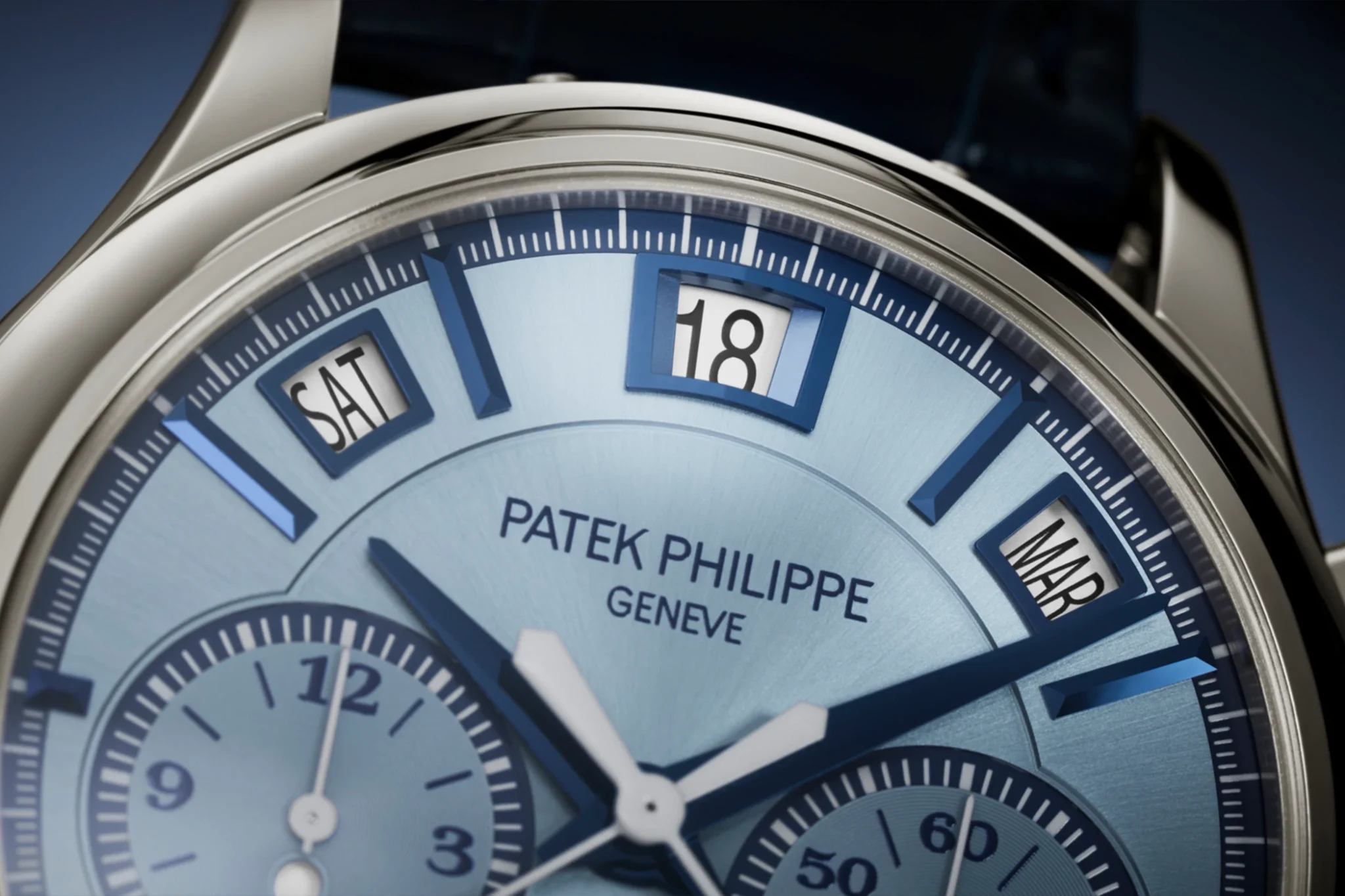
Using the lever on the case, the wearer activates the classic minute repeater, which strikes the hours, quarter hours, and minutes on two gongs. It is a tradition for Patek Philippe President Thierry Stern to listen to the sound of each watch and personally approve it for sale. The power reserve is at least 38 hours.
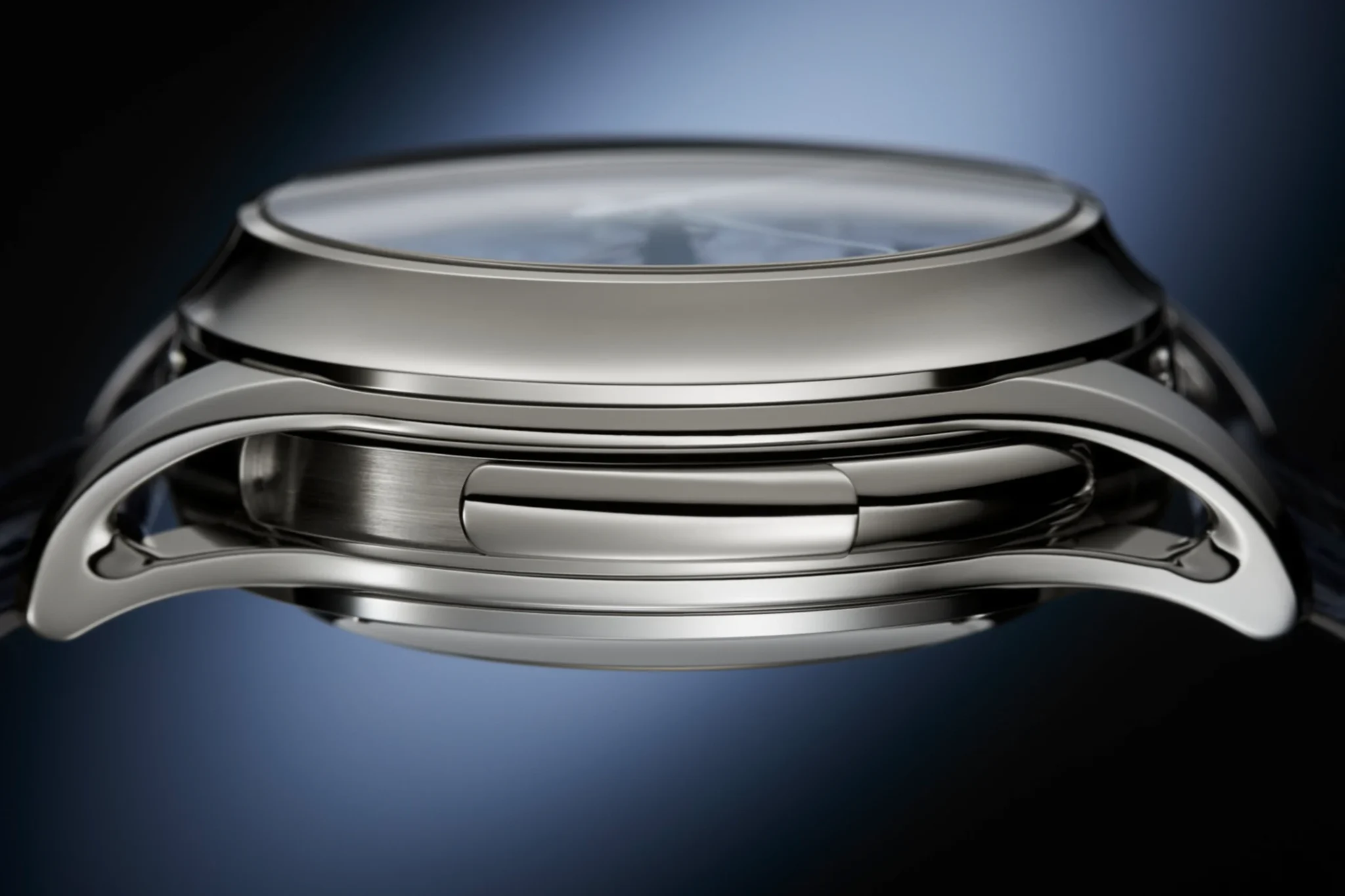
The watch features an ice-blue dial and a 42-millimeter white gold case with a height of 17.71 millimeters. The reference 5308G has a six-figure price tag: €1,216,710.
Roger Dubuis Excalibur Grande Complication
The Geneva-based manufactory Roger Dubuis is celebrating its 30th anniversary this year. Among watch brands that are partly over 250 years old, it is one of the youngest. This gives it the freedom to explore new paths in design. Distinctive features have already emerged. Typical are the case with a third horn, the bezel with notches, and the bi-retrograde display. All these elements are also present in the new Excalibur Grande Complication. In its complications, the manufactory has combined a minute repeater, a perpetual calendar, and a flying tourbillon with an automatic movement.
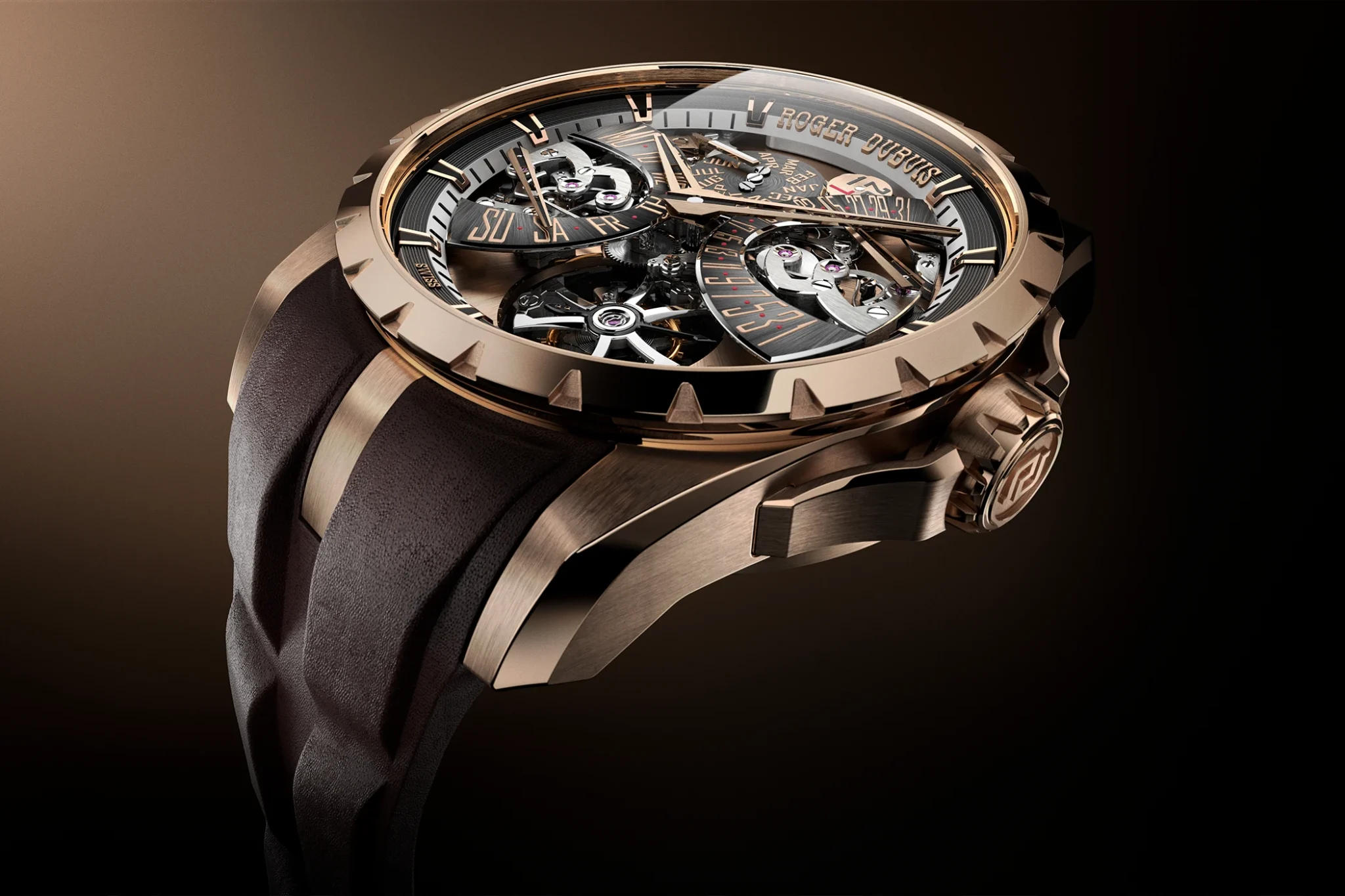
Like most perpetual calendars, Roger Dubuis also advances the days and months correctly in February and during leap years, needing adjustment only in the year 2100 when the leap year is skipped. While the weekday and date are displayed retrogradely, the leap year sequence can be found on a small disc above the month disc, where a fixed pin underscores the current month. Within the retrograde scales, the controlling mechanism with its snail cam can be seen. Below, the flying tourbillon is visible, and the shape of the cage is inspired by the Celtic cross.

The minute repeater is activated by a push button on the side of the case. It is sealed, making the Roger Dubuis one of the few minute repeaters water-resistant up to 50 meters. An “all-or-nothing” mechanism prevents a false, incomplete sequence from being struck if the button isn’t fully pressed. The sound is particularly remarkable as well: The gongs are tuned to the devil’s interval, or three whole tones, resulting in an unusual, dissonant sound.
Through the glass back, you can see the two micro-rotors of the caliber RD118. It offers a 60-hour power reserve and consists of 684 parts. The rose gold case measures 45 millimeters in diameter and is 17.45 millimeters thick. Roger Dubuis plans to produce only eight pieces. The price: €734,000.

A. Lange & Söhne Minute Repeater Perpetual
The German manufacturer from Glashütte presents an eternal calendar with minute repeater. When the slider on the side is activated, the hours sound in a deep tone, the quarter hours in a double tone, and the minutes with a bright tone, as usual. Its striking mechanism has been significantly improved and developed a silence cancellation feature. This avoids the pause between the hour and minute strikes, which normally occurs when there are no quarter hours to chime.
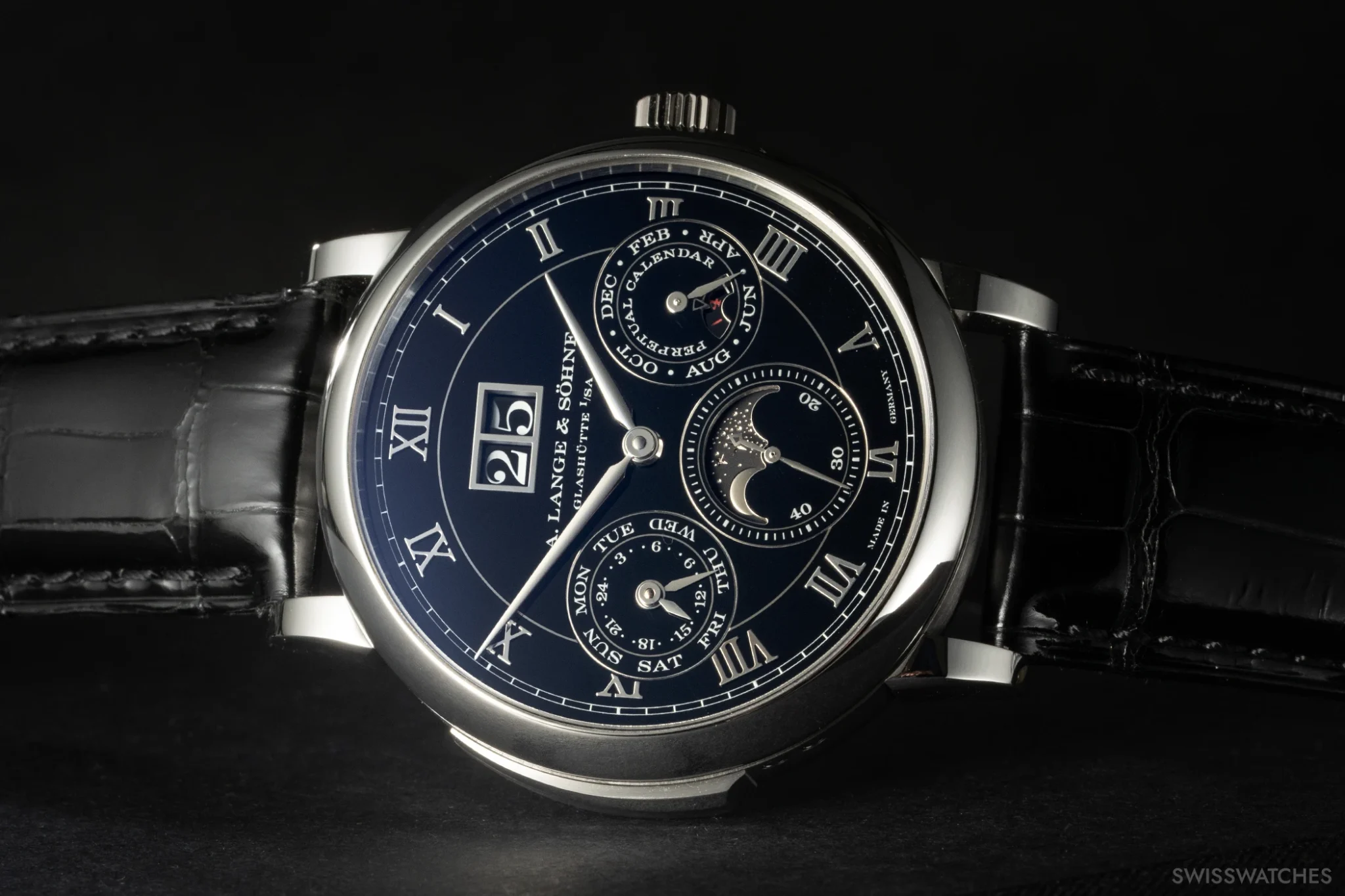
To prevent damage to the striking mechanism, the minute repeater cannot be activated when the crown is pulled, and the crown should not be pulled while striking. Thirdly, the hammer stop ensures that the hammer maintains a greater distance from the tone spring after striking, so it does not touch it again and affect its oscillation. The centrifugal regulator, which ensures the smooth operation of the striking mechanism, is now mounted on bearings and therefore operates very quietly. The tone springs are tuned by hand and adjusted for sound within the plating case. The striking mechanism alone consists of 194 parts.
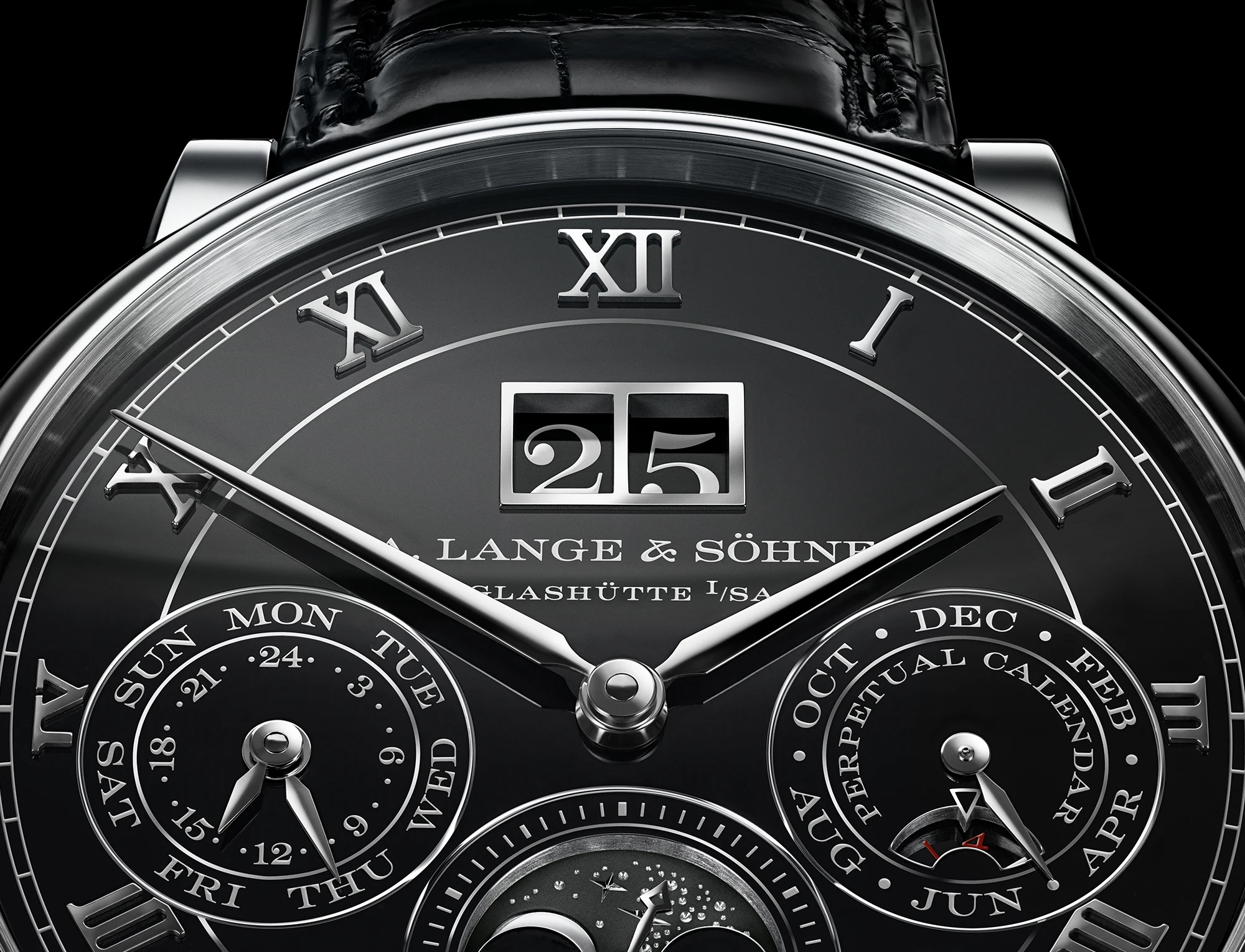
The perpetual calendar accounts for the lengths of months up to the year 2100. The lunar phase needs to be corrected only after 122.6 years. Through the glass bottom, one can see the hammers and the spiral springs of the striking mechanism. In total, the manufacture caliber L122.2 consists of 640 components, and it boasts an impressive 72-hour power reserve. Also noteworthy is the low height of the 40.5-millimeter case: at 12.1 millimeters, the Lange is considered one of the flat complication watches, and it is water-resistant up to 20 meters despite the minute repeater.
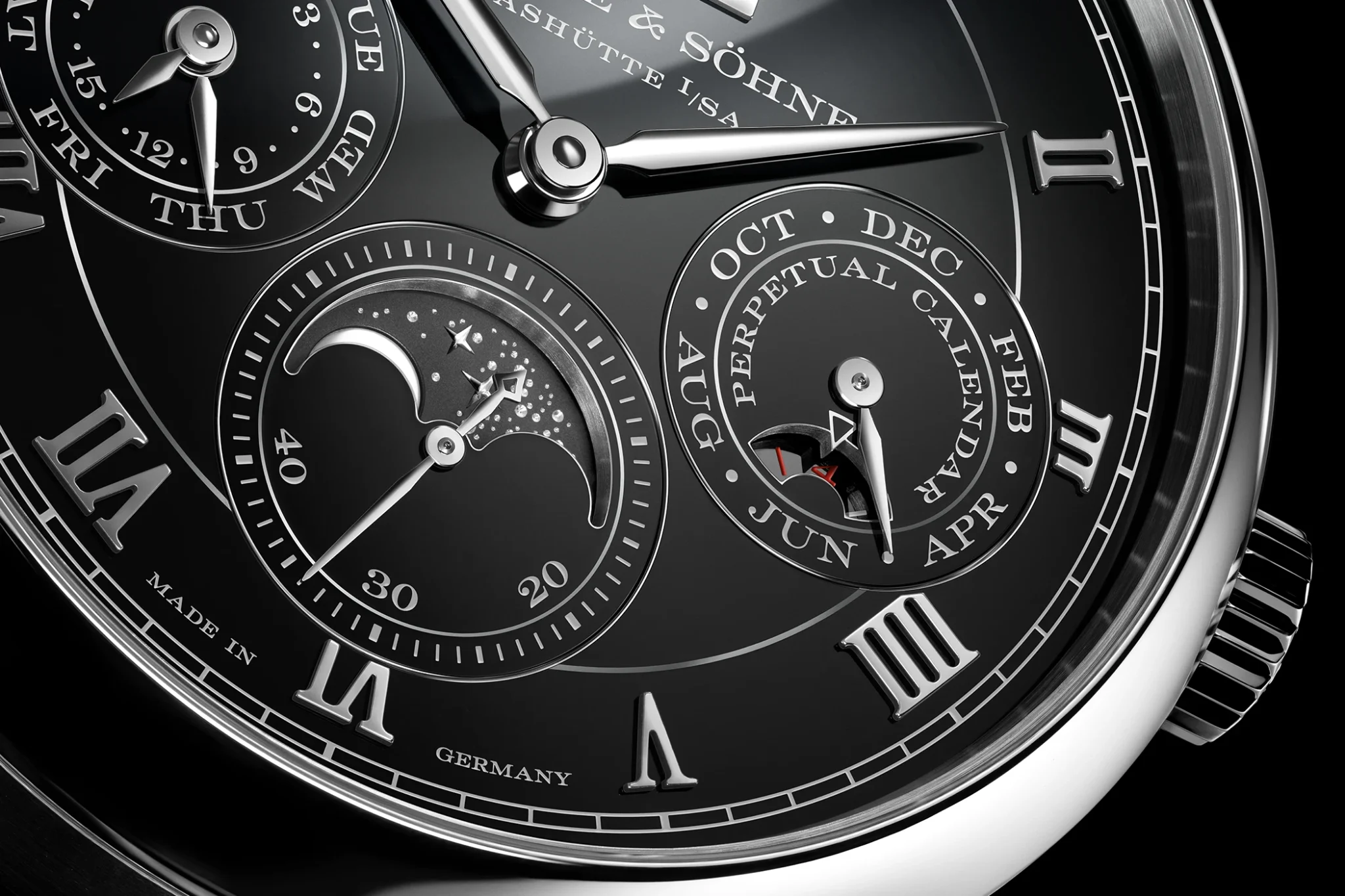
Jaeger-LeCoultre Reverso Tribute Minute Repeater
In 1994, the manufacture introduced a minute repeater housed in the iconic Reverso case. It was the brand’s first wristwatch minute repeater and the world’s first rectangular minute repeater. Since then, Jaeger-LeCoultre has developed and patented several innovations for striking clocks, which can also be found in the new Reverso Tribute Minute Repeater. These include Crystal springs, which are mounted directly to the glass, resulting in a fuller sound. The two-part Trebuchet hammers propel the hammerhead forward like a catapult, striking the tone spring more forcefully. The third innovation eliminates the pause that usually occurs when there are no quarter hours to chime.

The front of the Reverso features a hand-guilloché dial. The back, which can also be worn on the arm thanks to the reversible mechanism, displays the time as well, but aside from an outer minute scale and indices, it forgoes a dial, allowing you to admire the newly developed manual-winding caliber 953 with its hammers and centrifugal regulator. It has a power reserve of 48 hours.
The case in rose gold is only 12.6 millimeters high and is water-resistant up to 30 meters. Jaeger-LeCoultre is producing 30 pieces, each priced at approximately 320,000 euros.
Panerai Luminor Perpetual Calendar GMT Platinumtech
It’s quite surprising: The sixth watch on our list is the first one without minute repetition. However, this model from the brand that originated as an instrument maker for Italian combat swimmers has a significant complication as well. The perpetual calendar of this novelty displays only the relevant information—date and day of the week—in the tidy window on the front. On the back, you will find the information that is typically either already known or not needed: month, year, and leap year sequence. Also included here is the remaining power reserve of up to three days of running autonomy.

The functional design is complemented by the fact that the perpetual calendar can be fully adjusted forwards and backwards using the crown, without the need for recessed correction pushers. The 44-millimeter platinum case is water-resistant up to 50 meters. The Luminor with perpetual calendar is priced at €78,000.
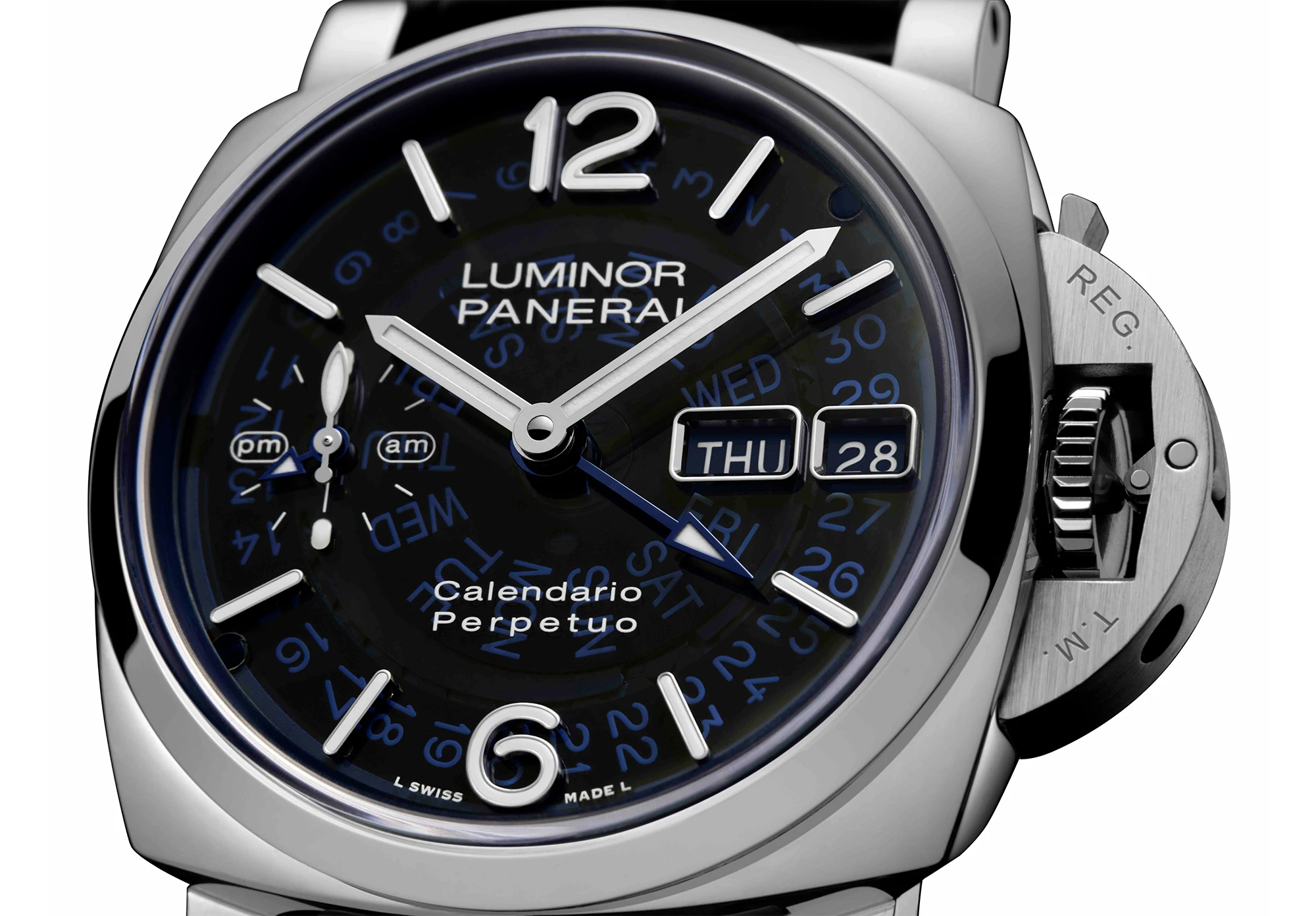
Bulgari Octo Finissimo Ultra Tourbillon
Bulgari has introduced the flattest watch with a tourbillon, measuring just 1.85 millimeters. To achieve this record, the brand had to delve deep into their bag of tricks: to eliminate the need for a dial, the bridge under the hands was skeletonized and the indices were carved out. Most of the wheels are mounted in a flying manner, meaning they are supported only on one side, which allows for the elimination of bridges on the other side. The base plate is made from extremely hard tungsten carbide and also serves as the case back. The bezel, middle case, and lugs are made of titanium. There is no crown – instead, operation is done via two wheels on the sides of the case: the right wheel is used to set the time, while the left wheel winds the movement.
In total, there were eight patents, including a new mounting method for sapphire glass, a novel spring barrel, the tourbillon module, and the titanium bracelet that is only 1.5 millimeters thick. The manual-winding caliber BVF 900 operates at a modern frequency of 28,800 vibrations per hour and has a power reserve of 42 hours. The 40-millimeter record watch will be produced 20 times and is priced at 750,000 euros.

Rolex Land-Dweller
The completely new Land-Dweller model with an integrated steel bracelet also boasts technical innovations: the new flat automatic caliber 7135 can be viewed through the transparent case back. It is based on the 7140 from the 1908 model but distinguishes itself with several technical innovations and a revolutionary escapement. The movement has received 16 patents, and its development took seven years.
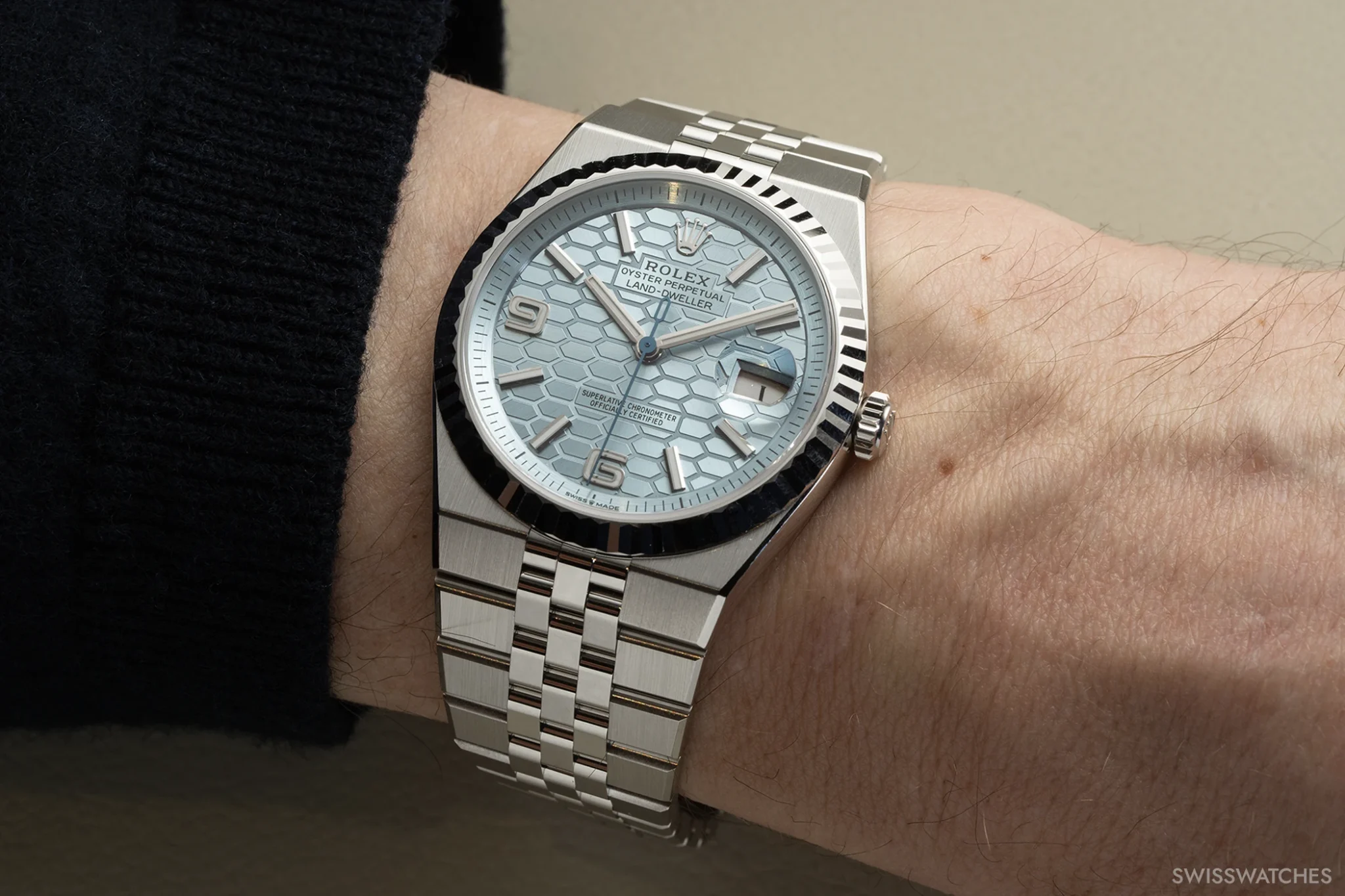
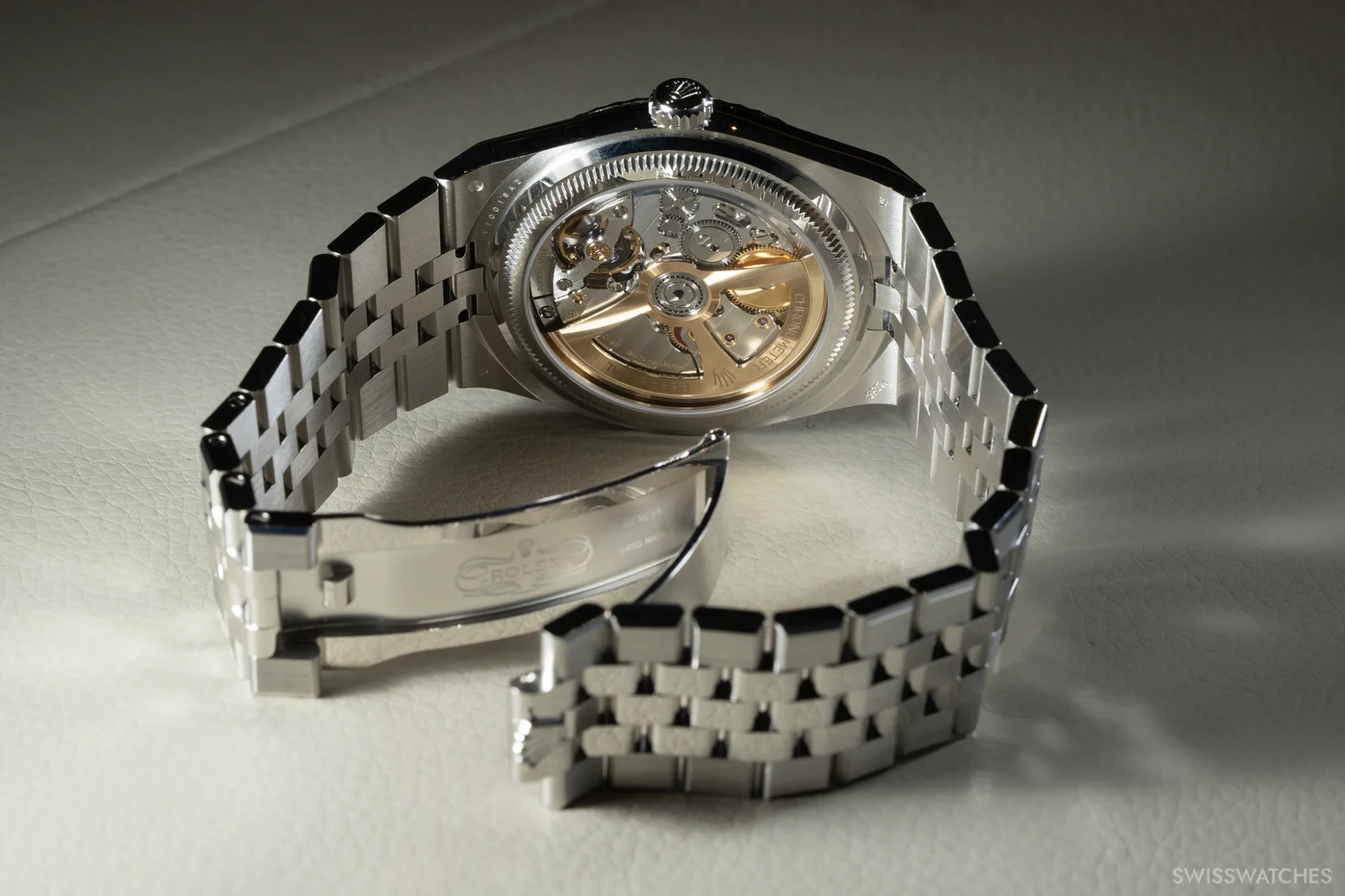

The Dynapulse escapement developed by Rolex is primarily made of silicon, making it lightweight and resistant to magnetic fields. In addition, it is designed to be particularly energy-efficient. Unlike the Swiss anchor escapement, it operates without sliding friction, allowing it to function even without lubrication if necessary. The balance wheel has also been further developed.
The balance staff is made of ceramic, and the optimized Paraflex shock absorption system supports both sides of the balance staff. According to Rolex, the balance rim is made from “optimized brass,” a new alloy that is also said to withstand strong magnetic fields.
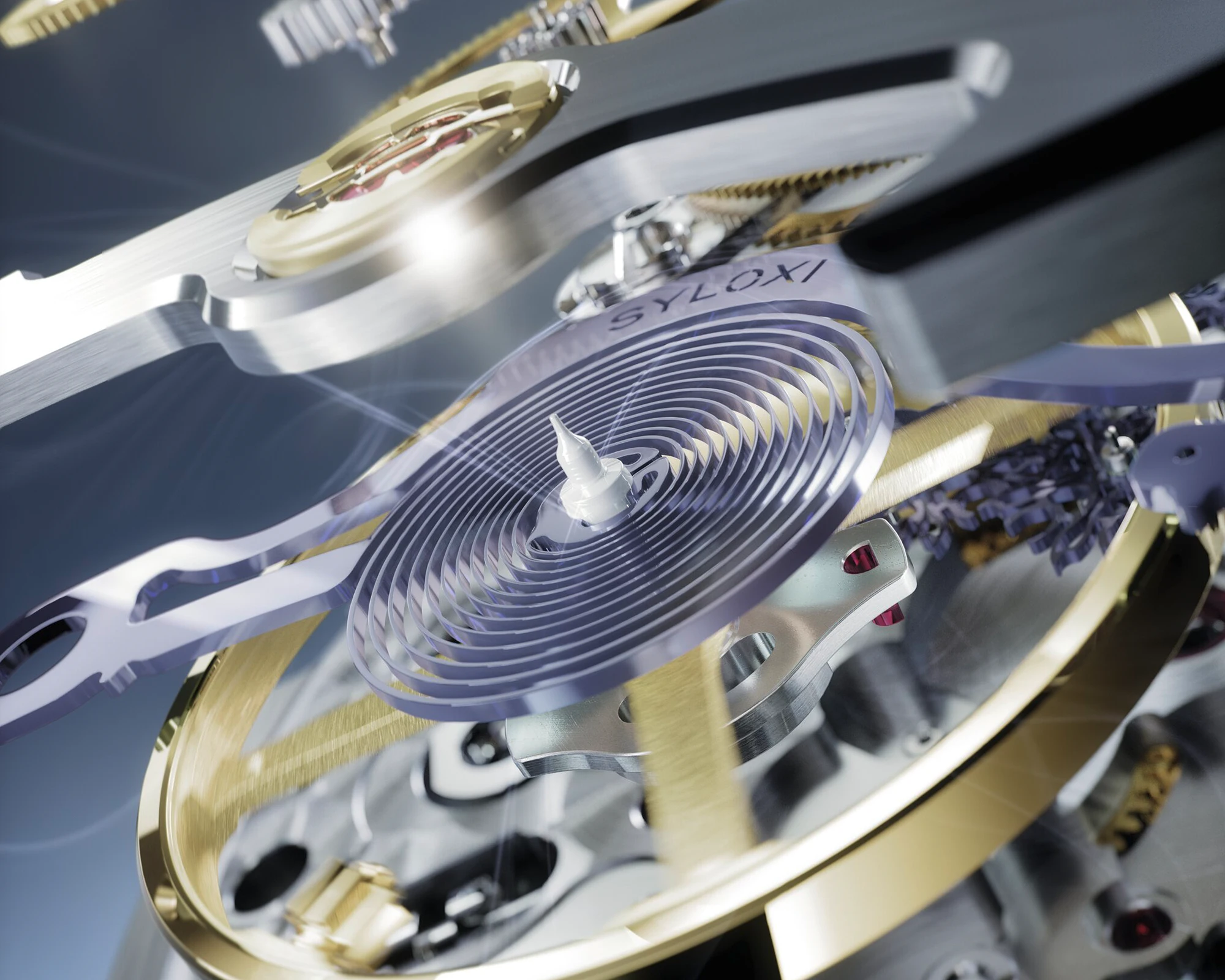
The Siloxi hairspring made of silicon, which Rolex has already used in a women’s movement and in the caliber of the 1908, provides high resistance to magnetic fields here as well. Another novelty for Rolex is the increased frequency of 36,000 beats per hour, as the brand has worked with 28,800 A/h for decades. A higher frequency typically results in greater precision and reduced susceptibility to shocks, but it often comes with a shorter power reserve. However, thanks to the lightweight Dynapulse escapement, caliber 7135 achieves an above-average power reserve of 66 hours.
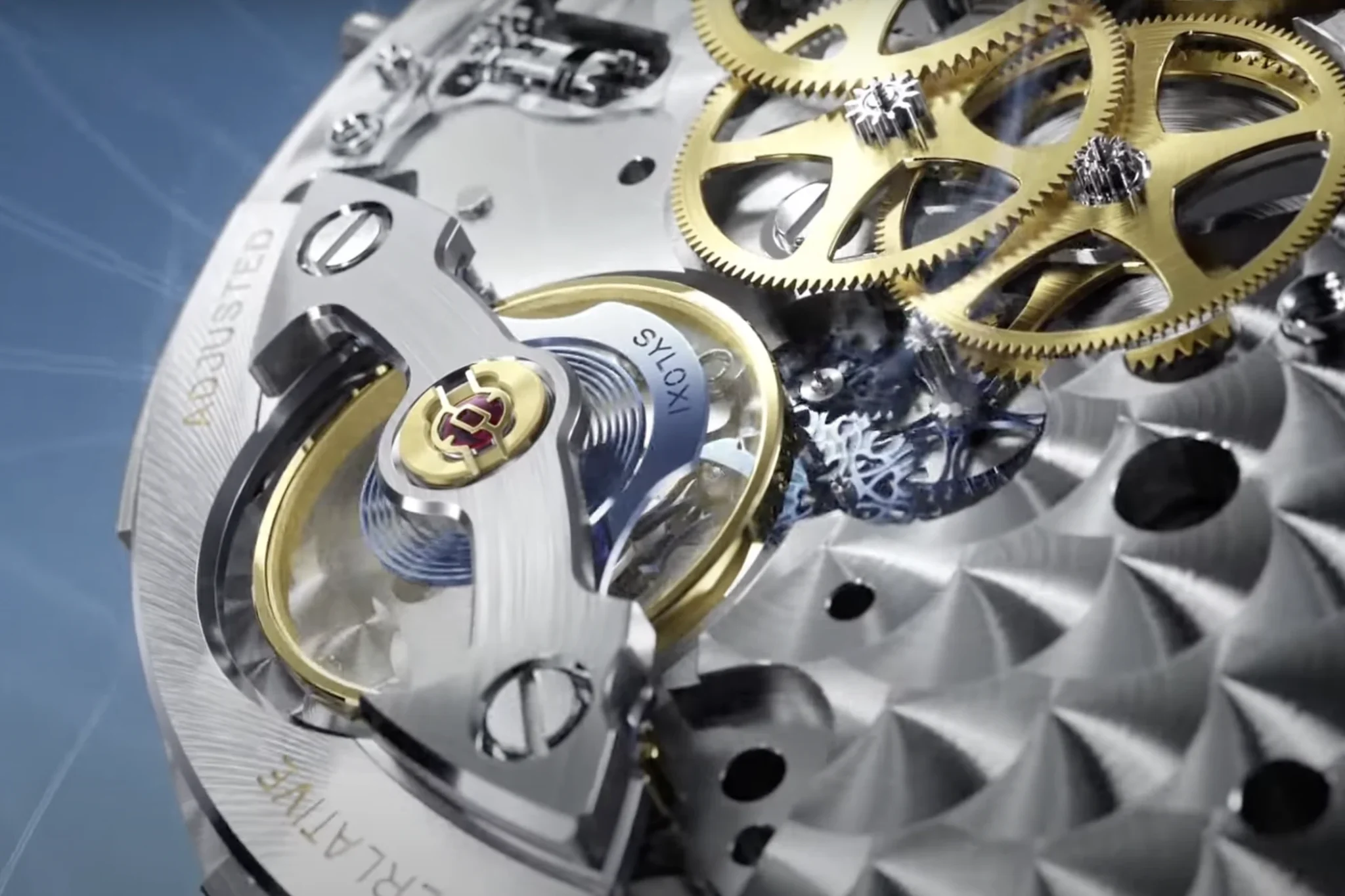
Thanks to the new factory, a flat case has been realized: The 40-millimeter Land-Dweller is only 9.7 millimeters thick. Despite its slim profile, the watch remains water-resistant up to 100 meters and is protected by a Twinlock crown. The Land-Dweller, housed in a 40-millimeter stainless steel case with a white gold bezel, is priced at 15,350 euros.
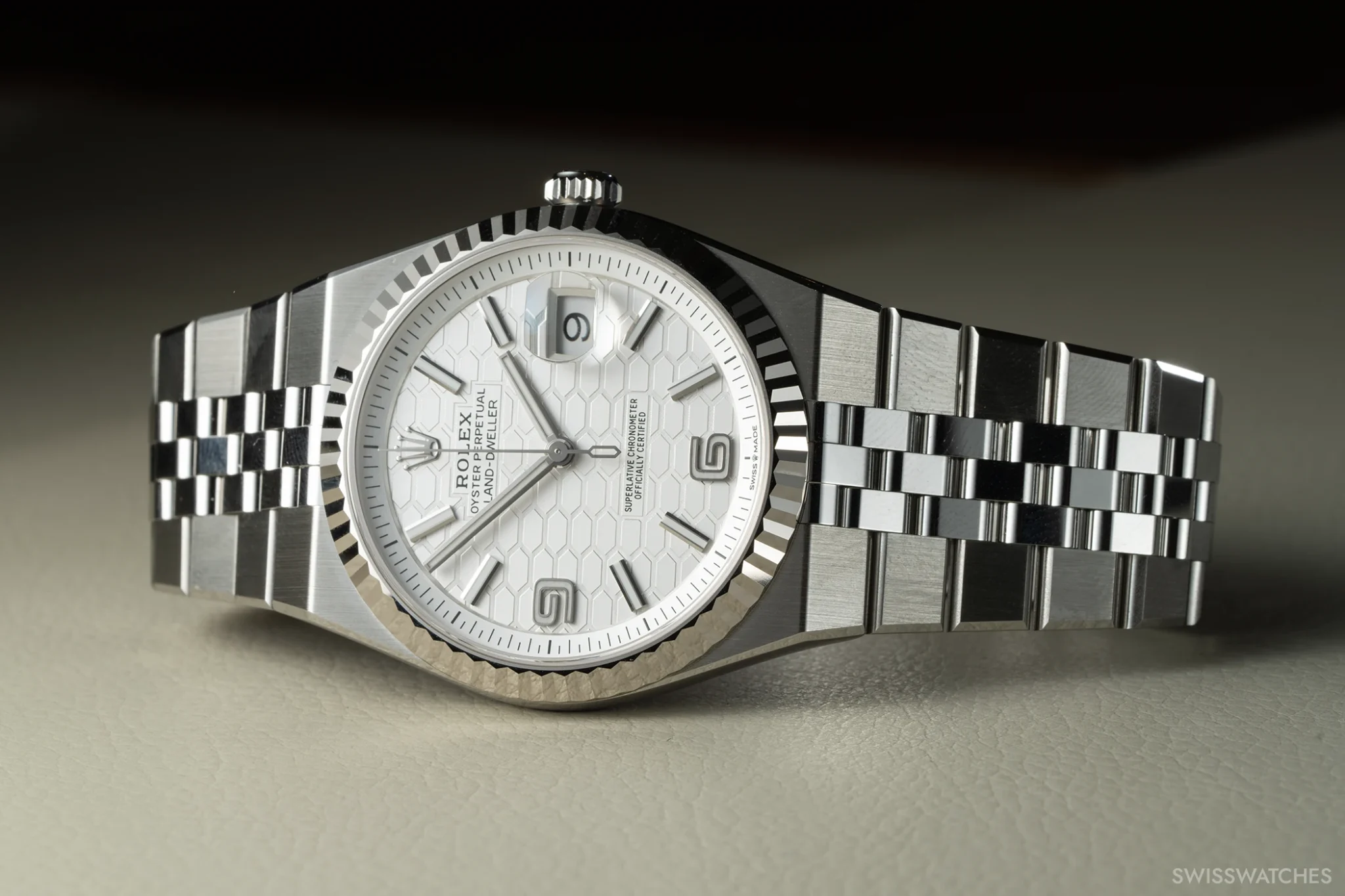
Grand Seiko Spring Drive U.F.A.
Grand Seiko introduces the Spring Drive U.F.A., the most accurate mechanical watch with a mainspring: the deviation should be a maximum of 20 seconds – per year! This is only possible with the Spring Drive technology developed by Seiko. The rotor winds the mainspring, which drives the gear train just like in a mechanical watch. Instead of a escapement and balance wheel, the Spring Drive caliber features a glide wheel. On one hand, it generates electrical energy for the quartz oscillator and the chip with integrated circuitry like a dynamo, while on the other hand, the integrated circuit compares the pulse signal of the quartz oscillator with the rotational speed of the glide wheel and employs a magnetic brake to adjust the glide wheel to the precise speed.
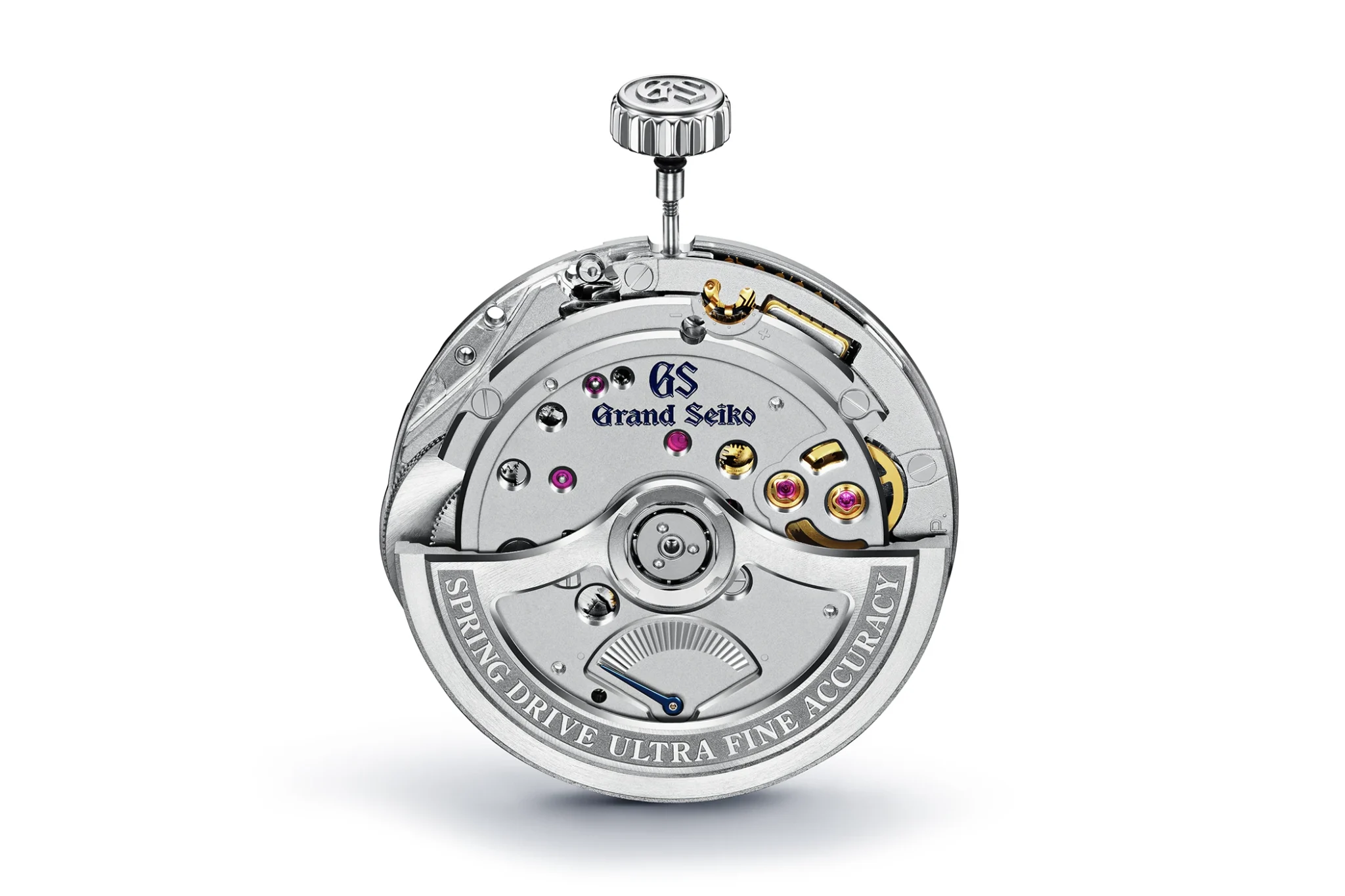
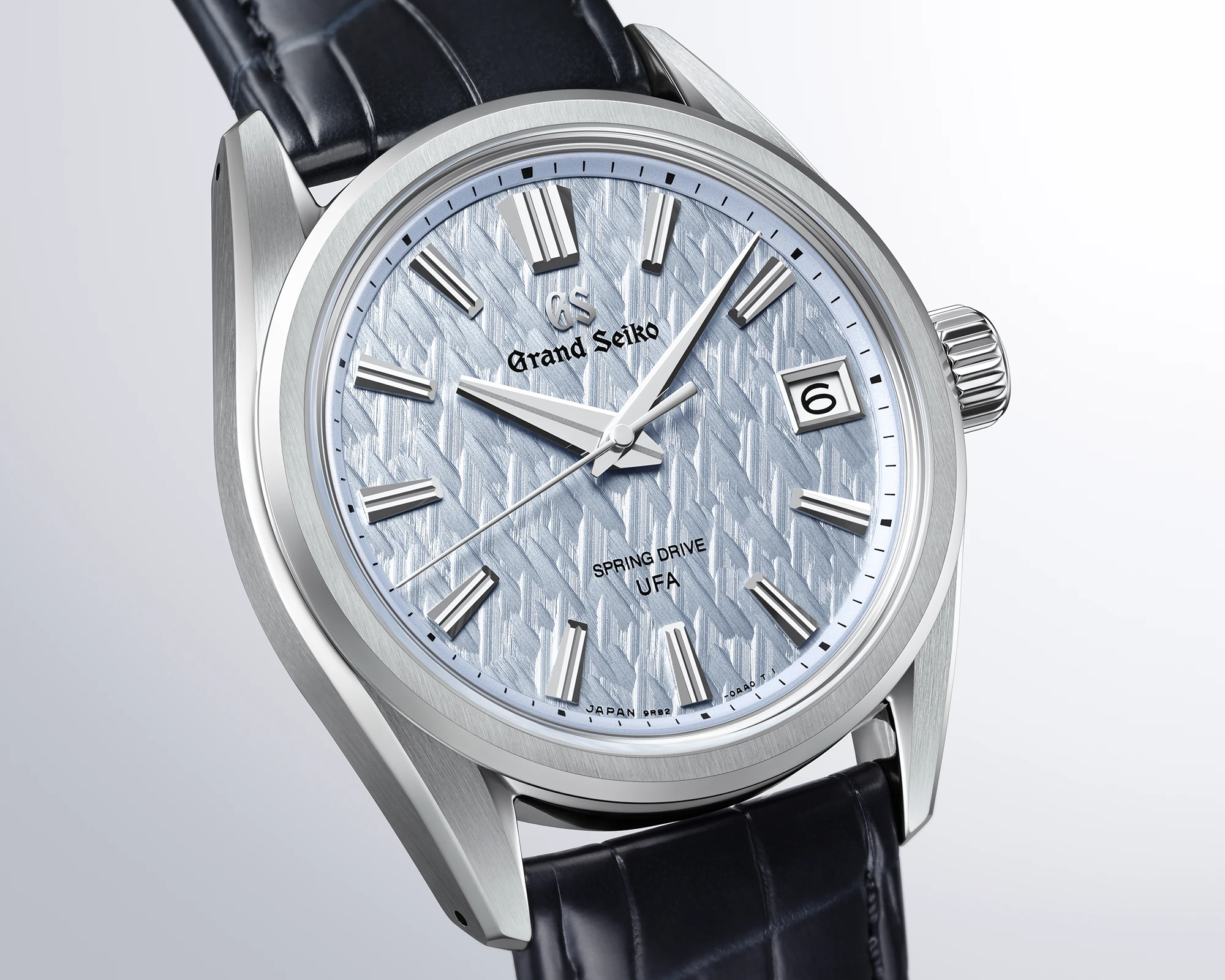
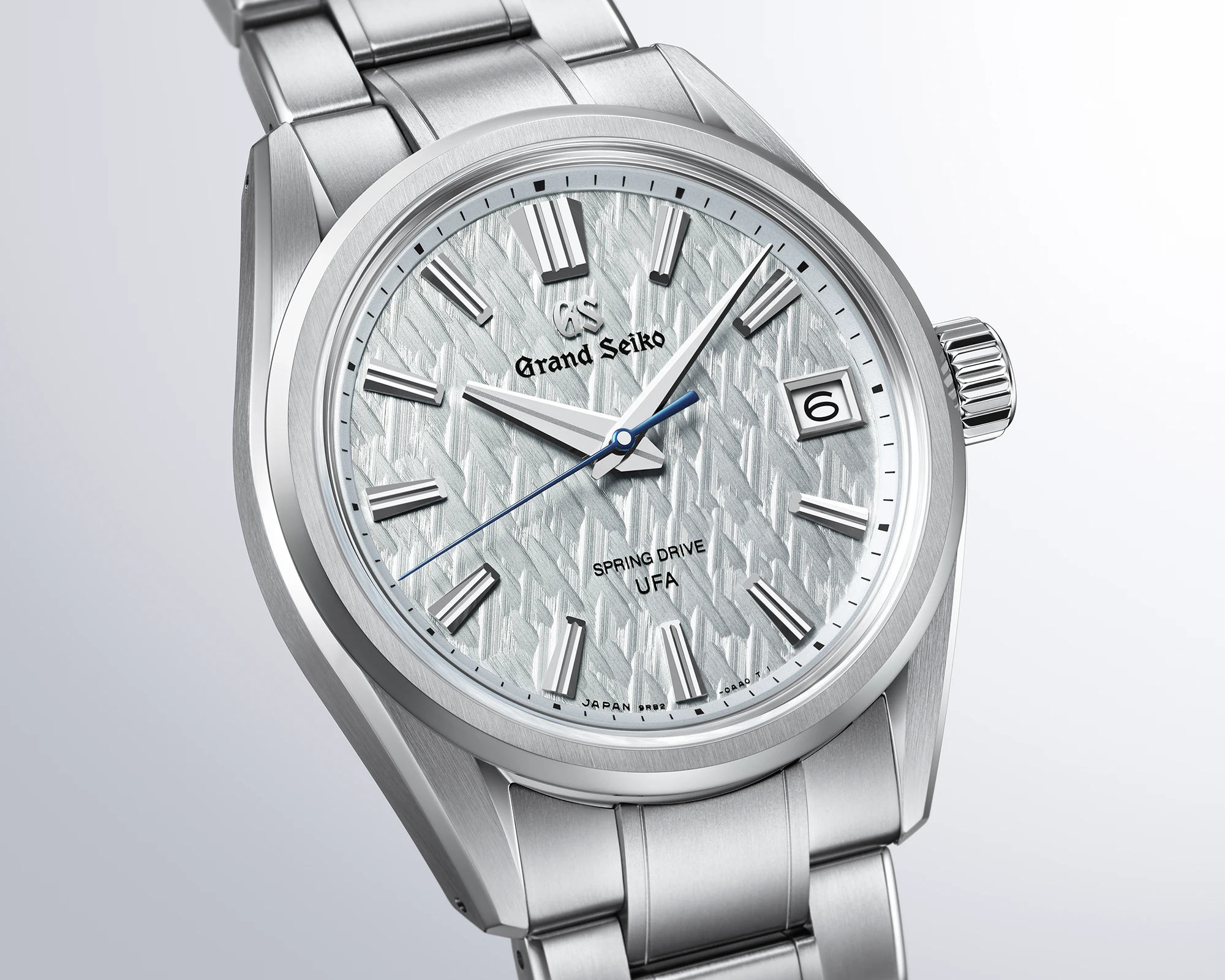
This mechanical quartz hybrid system without a battery operates with remarkable precision: Even its predecessor, the Grand Seiko Spring Drive Caliber 9R65 introduced in 2004, achieved a monthly accuracy of +/-15 seconds. The new Spring Drive Caliber 9RB2, featuring the addition U.F.A., which stands for “Ultra Fine Accuracy,” is now nearly ten times more accurate, achieving +/-20 seconds per year. This extraordinary value is achieved through a new, improved manufacturing and processing method of the three-month aged quartz oscillator and the integrated circuit. Both the oscillator and the sensor are vacuum-sealed to minimize temperature variations and protect against external influences like moisture, static electricity, and light. This ensures precise temperature regulation and stable performance of the quartz oscillator. Additionally, for the first time in Spring Drive, the new movement includes a regulation mechanism that can be used during servicing to correct deviations in accuracy that may occur with extended use.
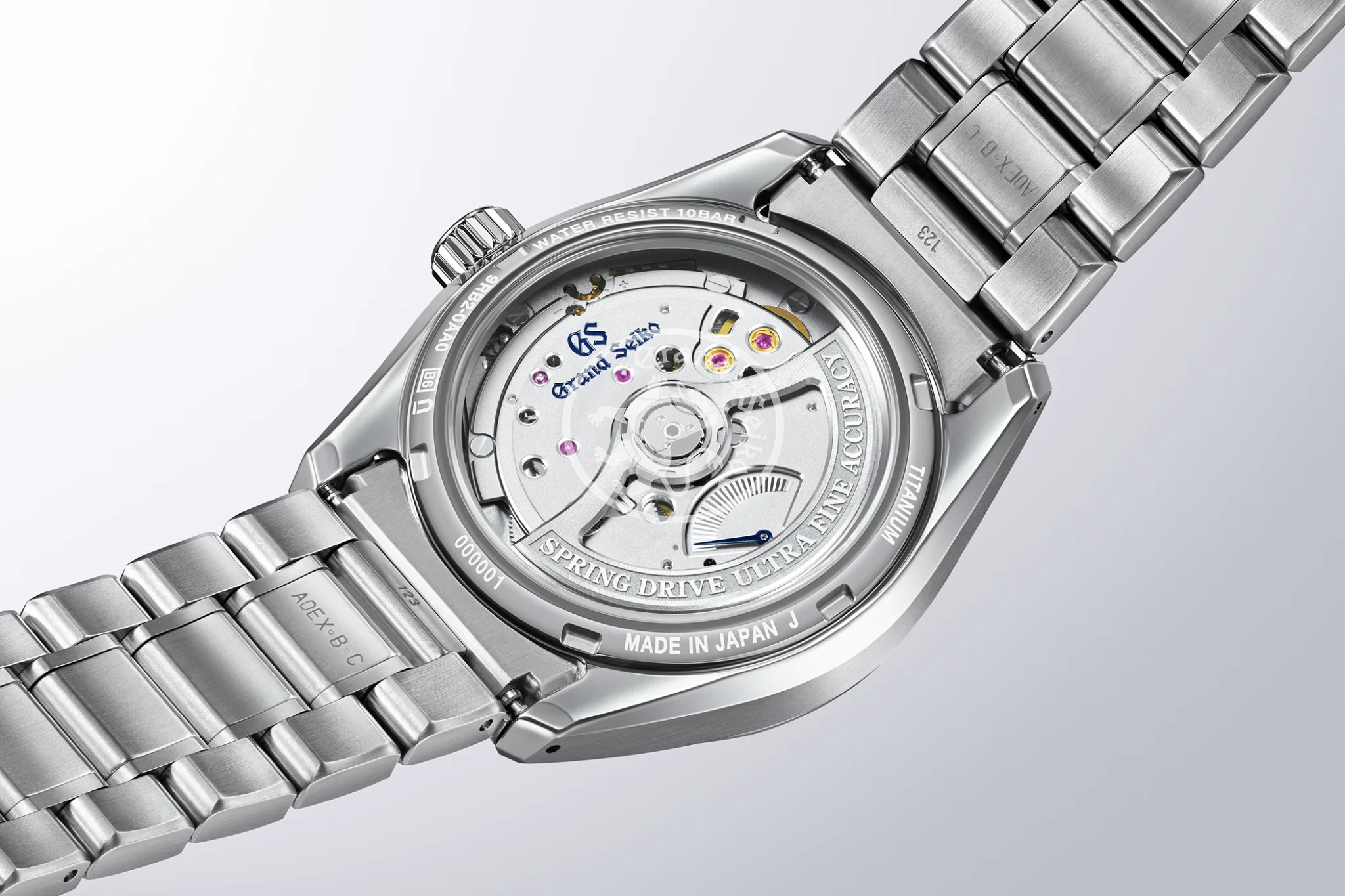
The finely decorated movement can be seen through the glass case back. It has a power reserve of up to 72 hours and features a power reserve indicator on the back. The new model, housed in a 37-millimeter titanium case, is priced at 12,000 euros.

